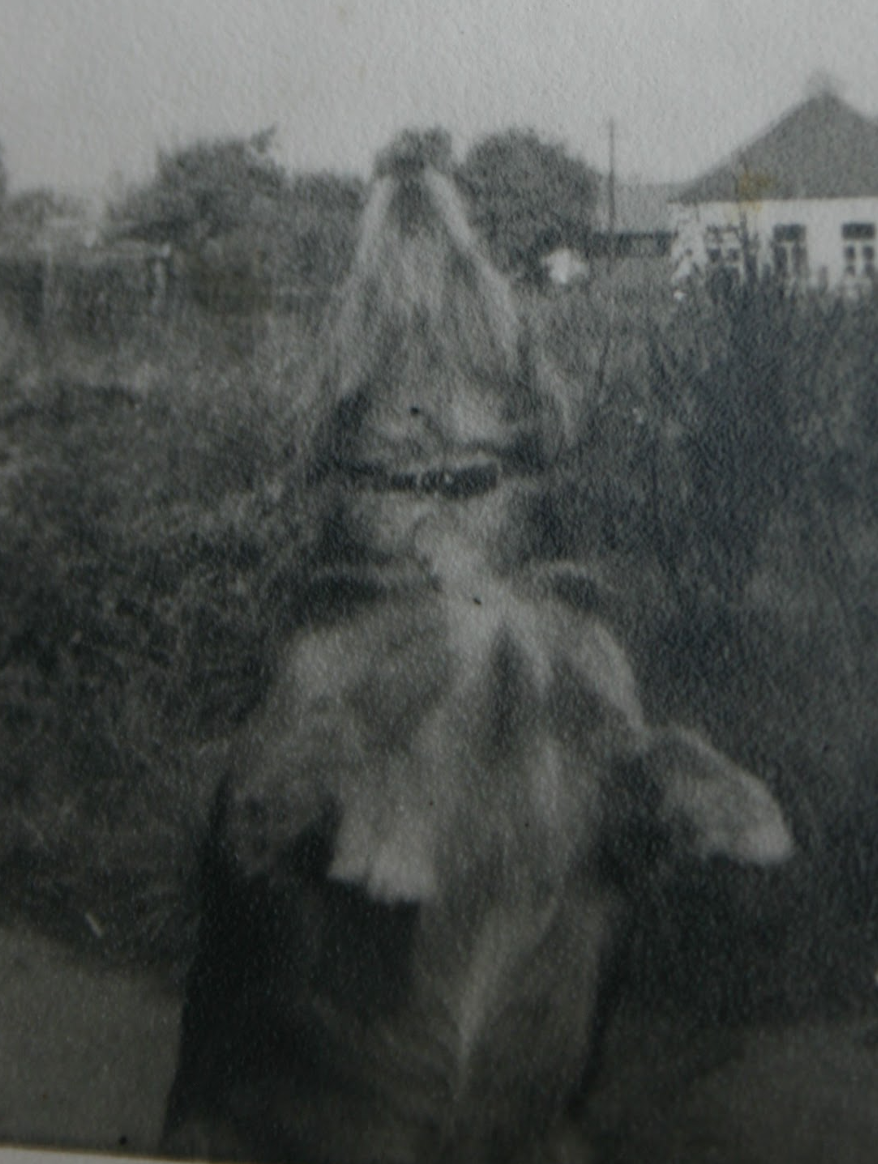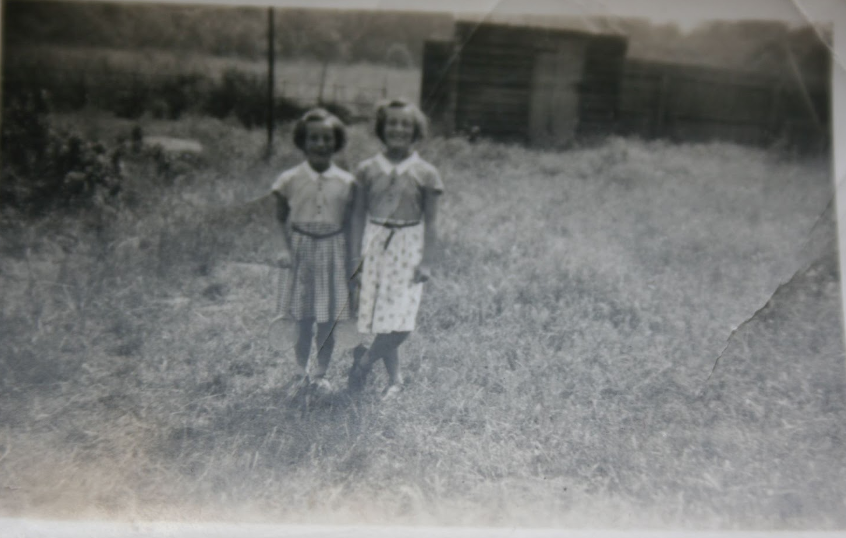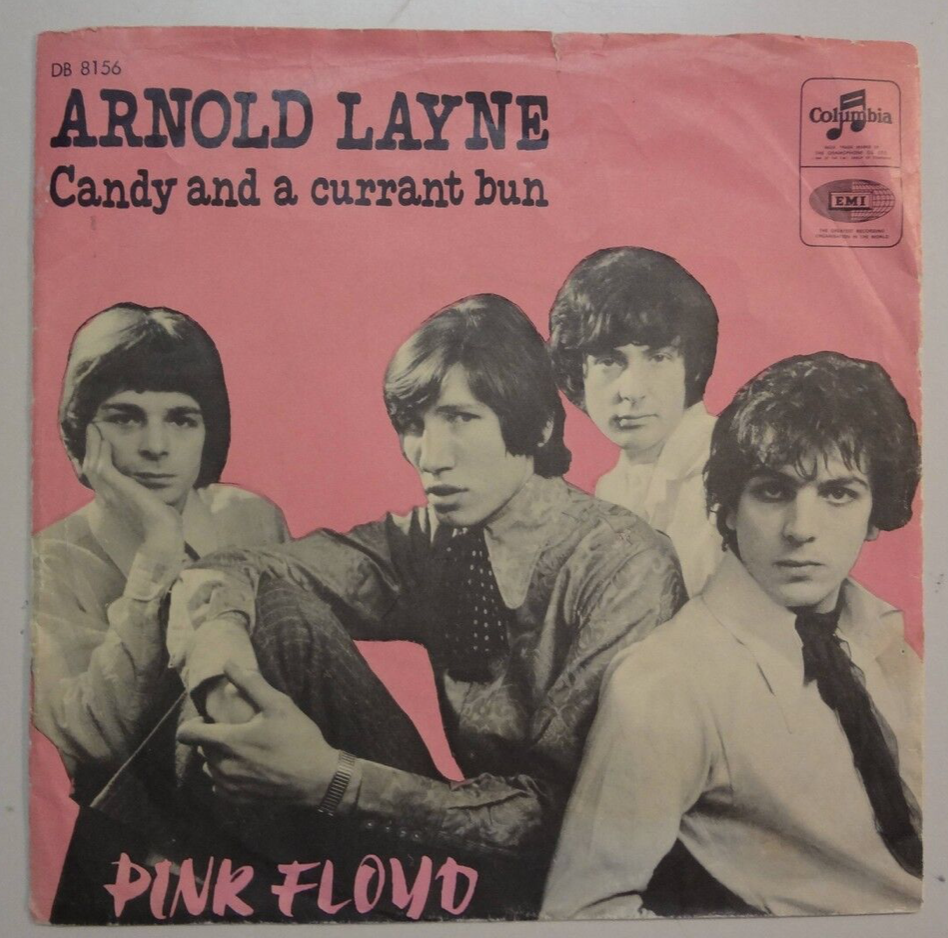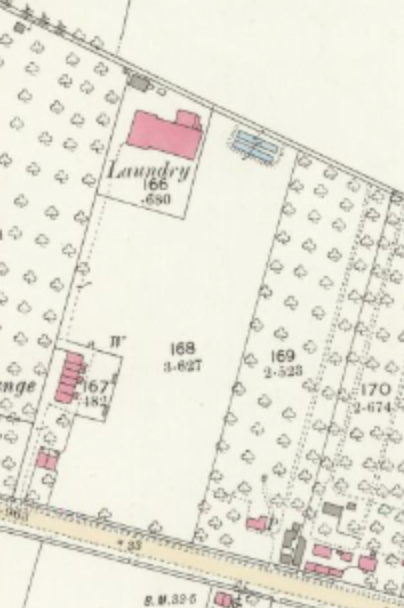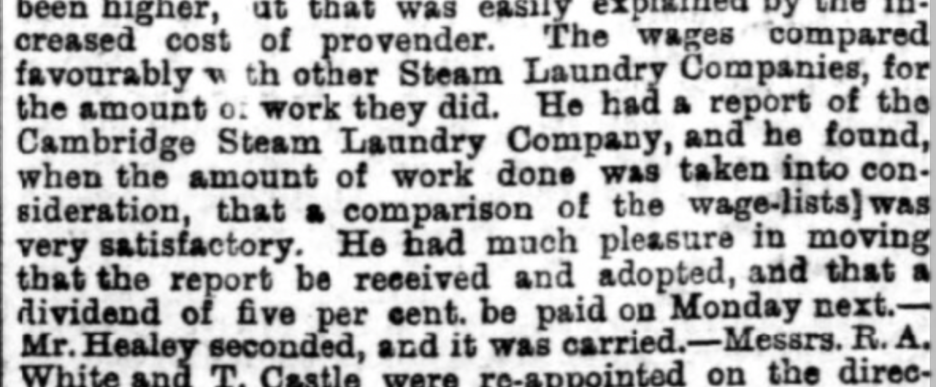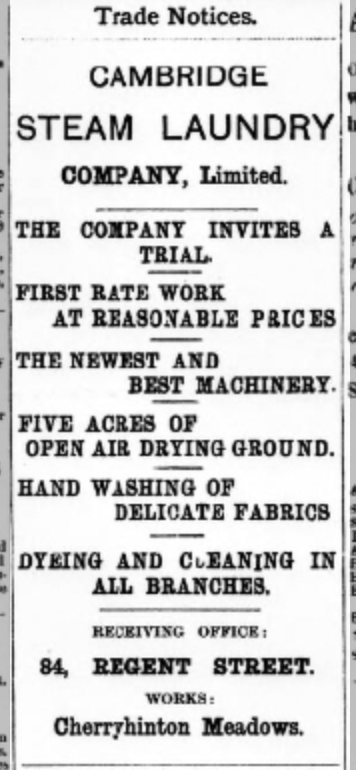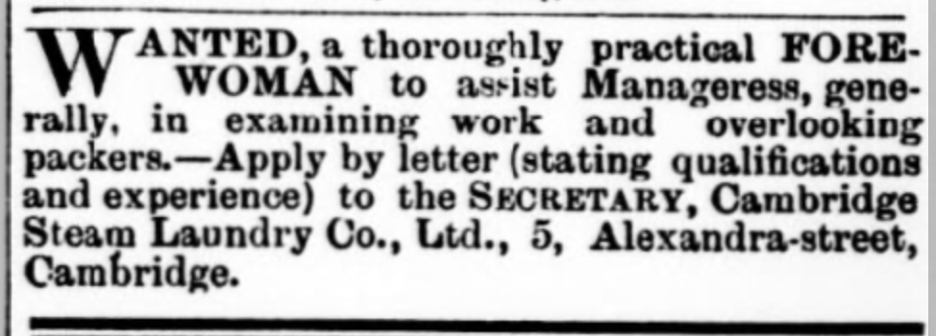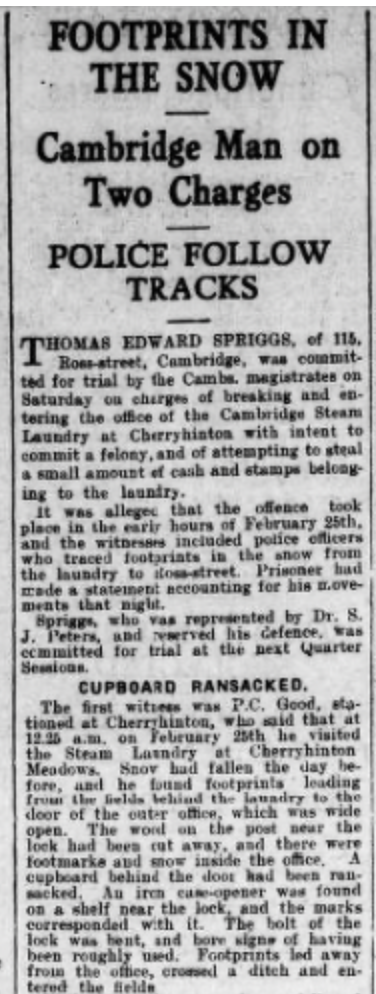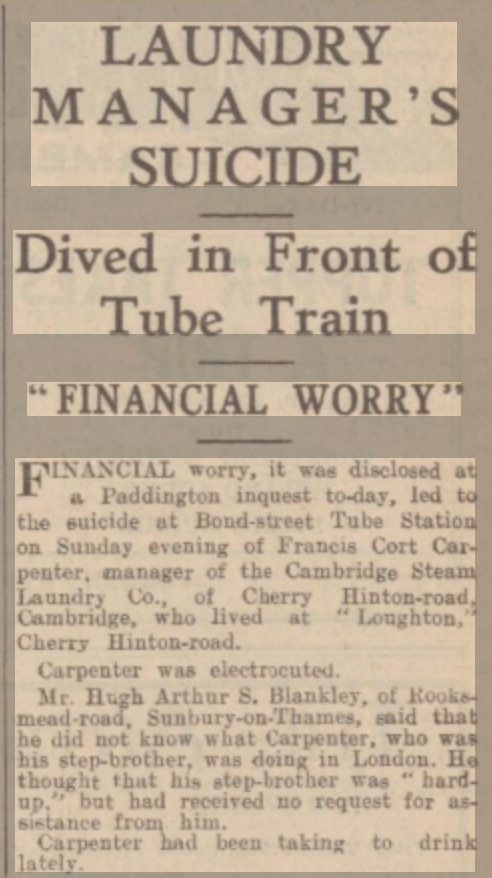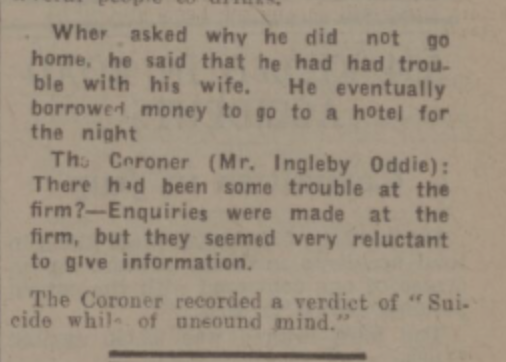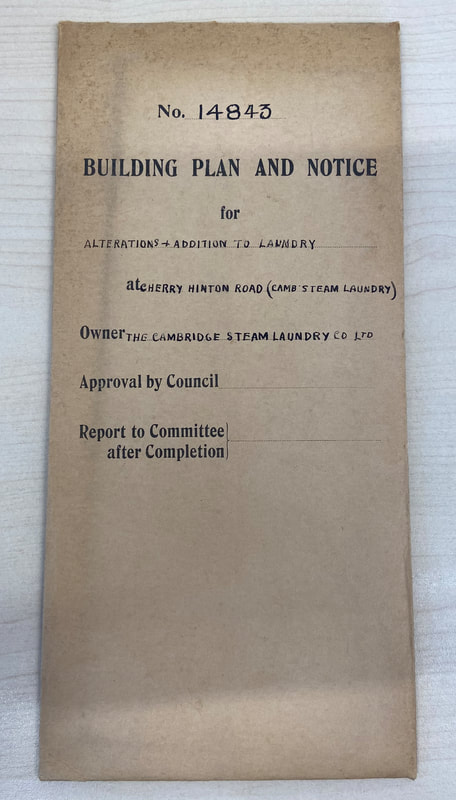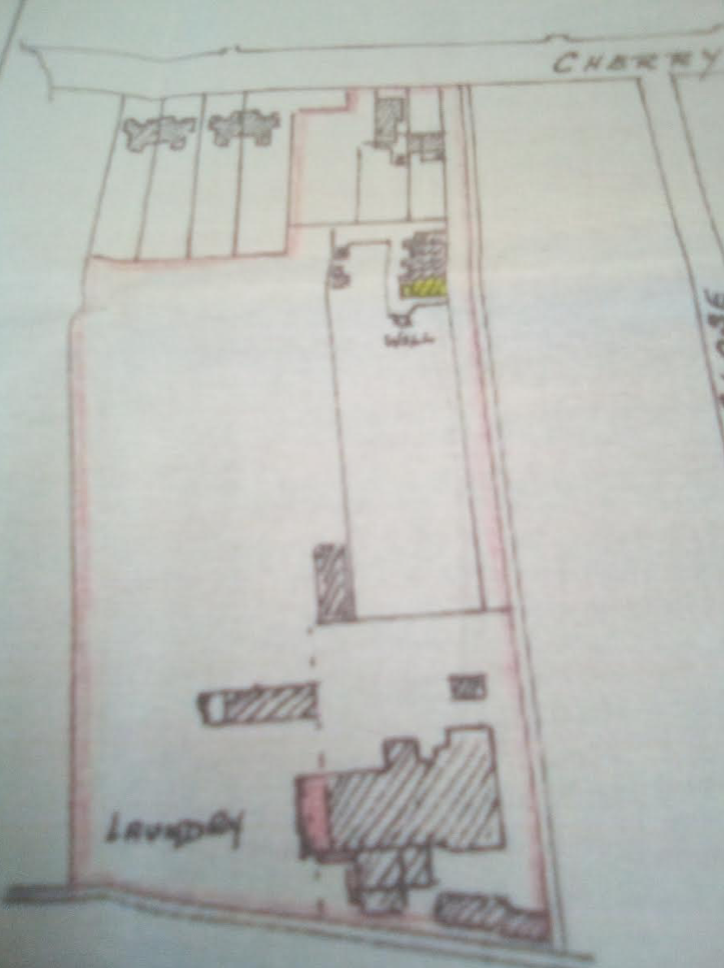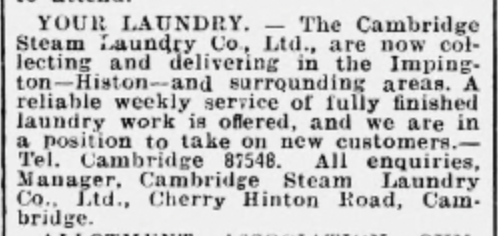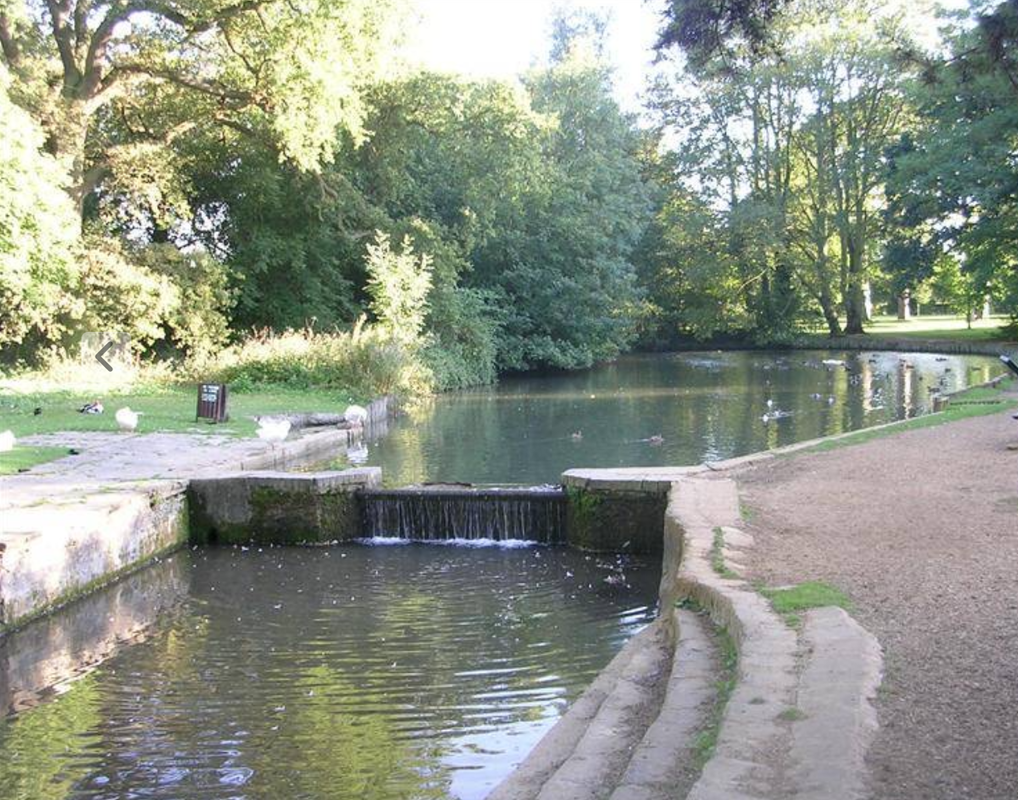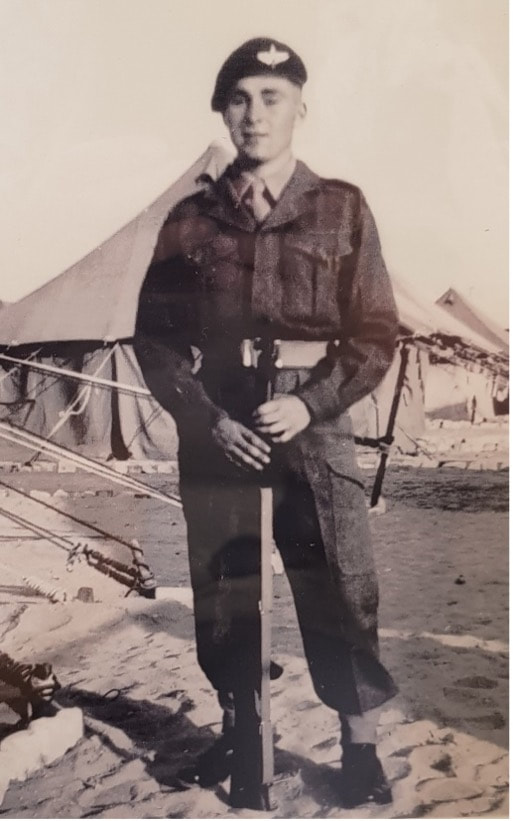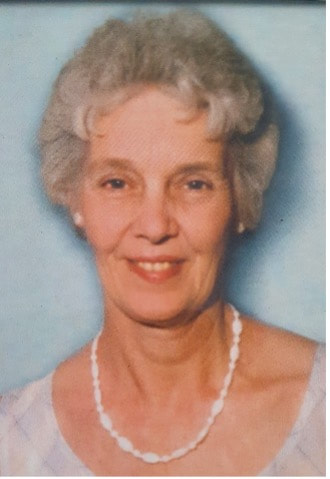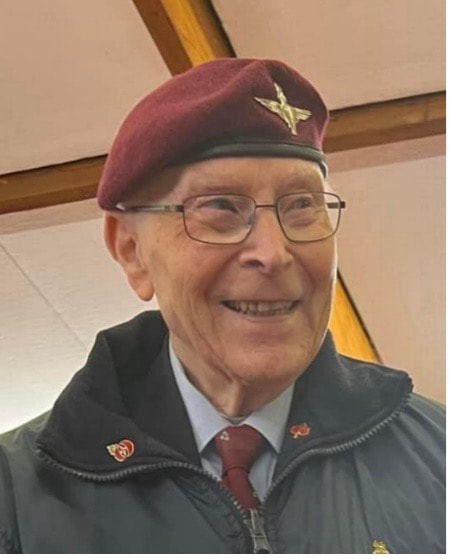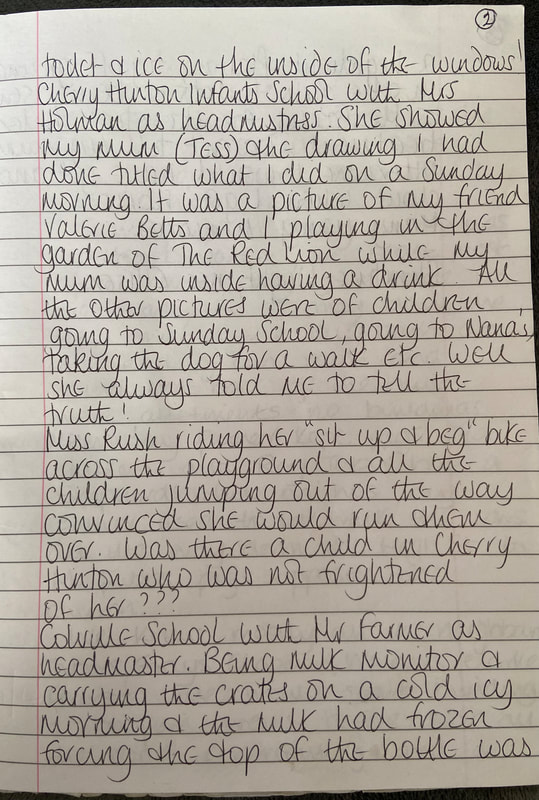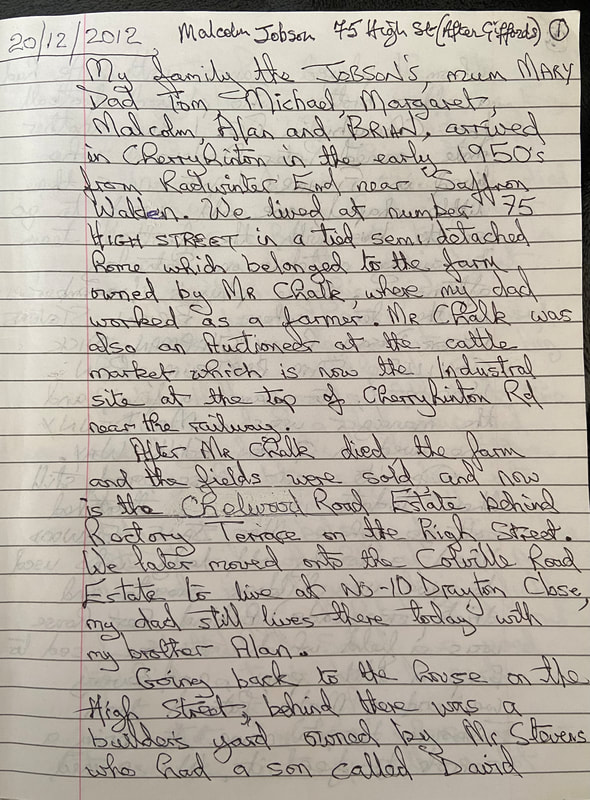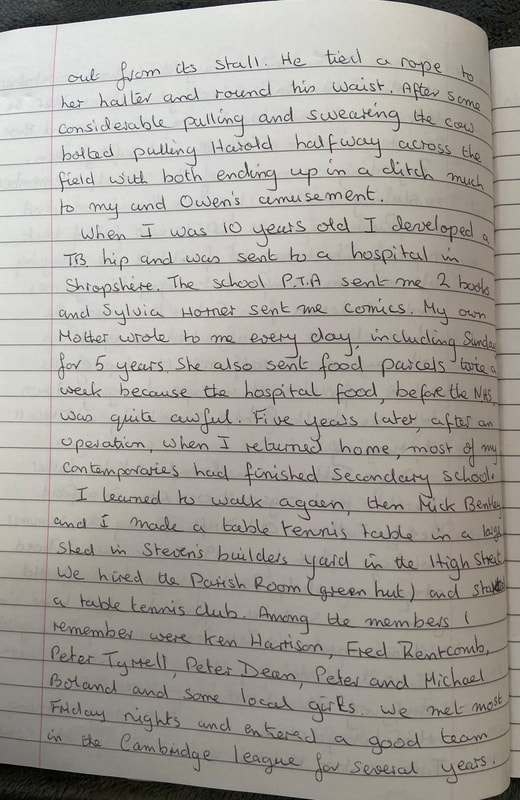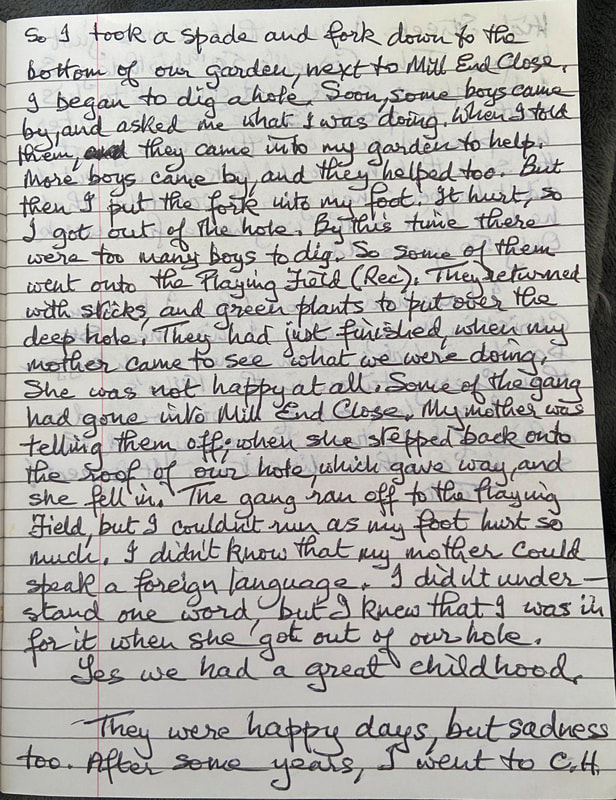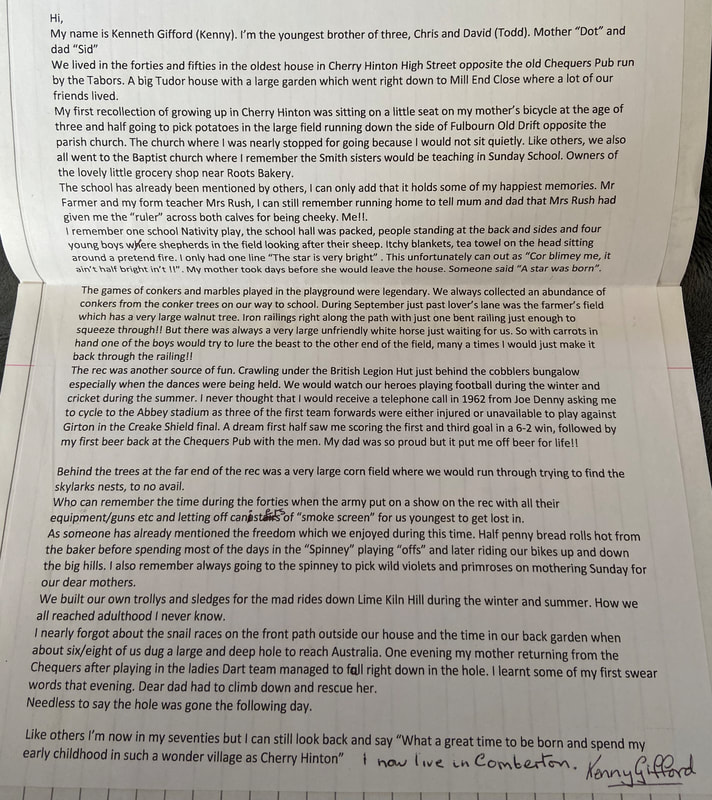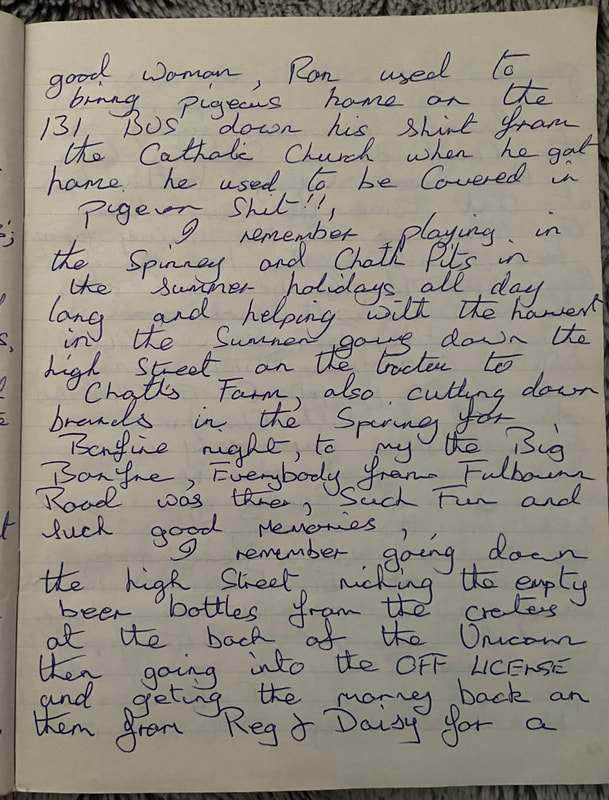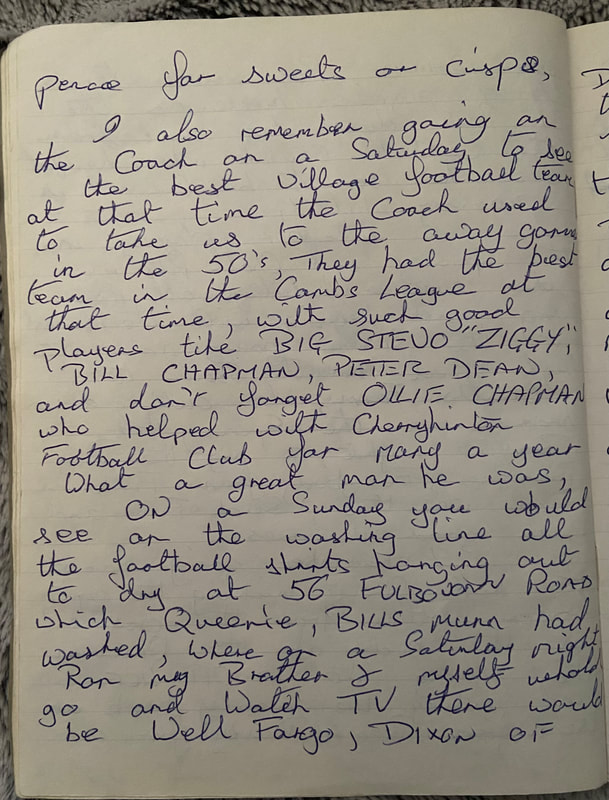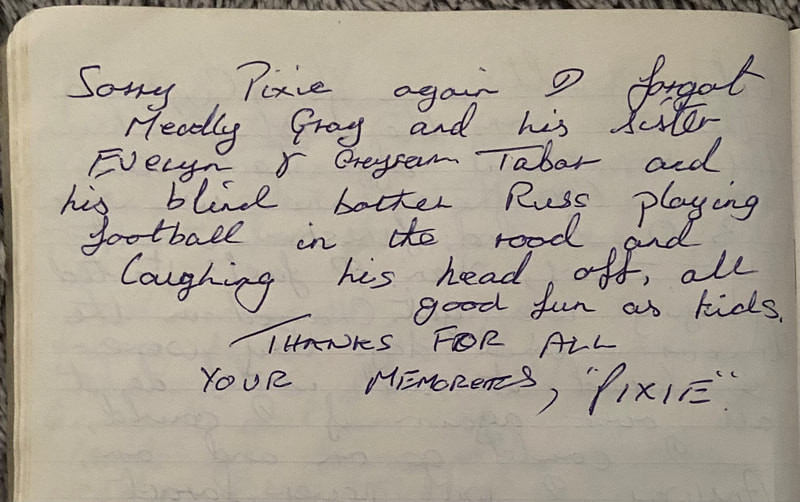|
Memories of Laundry Lane by Penelope (Penny) Jackson
My Early Life living in Cherry Hinton Road & Laundry Lane
Family
Ruby Gladys Jackson (Mum) William (Bill) Ernest Jackson (Dad) Sisters Ellen Margaret, and me Penelope
*All photographs included here are Penny's, unless otherwise stated.
I was born on 28.04.1948 at 141 Cherry Hinton Road where my family lived in a downstairs flat. I was the youngest of three girls, Ellen was the eldest, she was born in North London in 1940, Margaret followed in 1946 and I came along later in 1948. Margaret and I were both born at 141 Cherry Hinton Road. My parents decided after the 2nd World War to move away from London and make Cambridge their home.
I believe that my dad's first job in Cambridge was at the Swiss Laundry on Cherry Hinton Road, which was not far from our home. My dad was an engineer, and he eventually left his job at the Swiss Laundry and worked for the Cambridge Steam Laundry which was at the end of Laundry Lane off of Cherry Hinton Road in Cambridge.
The job came with a cottage which was located at Laundry Lane, our cottage was number 1 Laundry Lane which was the cottage nearest the Laundry, there were 5 other cottages and as far as I can recall, all were occupied by other laundry workers.
I recall that there was a family called Arnold who lived at number 3 Laundry Lane, Cecelia Arnold was the eldest and I think Len was her son, there was a young lady called Ella and I remember a young man called Ricki. At some point, there was a baby boy living in the Arnold household and I guessed he was Len's son, his name was Kevin.
There was a family whose surname was Cramer. I think the dad was Polish. I cannot remember his wife's name, but I remember he had 2 daughters. I think one of the daughters was named Barbara, the other I think was Marisha but I am not sure.
There was a family called Inskip but I cannot remember what number they lived at, but they had two children Michael and Christine. At the end of the row of cottages was a couple who did not have any children, they were Tom and Ivy Cordon, and I can remember when Queen Elizabeth was Crowned (1953) they let us children watch the ceremony on their TV because none of the other residents had one! They were also the only ones who had a car.
There was another little cottage in Laundry Lane, it was nearer to Cherry Hinton Road. There was a little girl called Freda Mauer who lived there with her parents, her dad's name was Steve.
Post-war, money was tight, but as a child, it seemed to be a happy community. At the back of the row of cottages, we all had back gardens and to the side of the houses was a plot of land which was turned into allotments for growing vegetables. There was also a well on this piece of land.
Beyond our back gardens was a big field, where in the summer the children used to play during the school holidays. In early summer the field was covered with cowslips, which today are still my favourite flower. The boundary of the field had a row of trees and beyond the trees was Coe’s Farm. Mrs Coe ran a shop, the front of which was on Cherry Hinton Road. The shop was opposite where the TA is now.
(* You can read more about the Coe's by clicking here: Lime Tree Farm and the Coe Family, Cherry Hinton)
Ellen went to Morley School and when she left there she went to Coleridge School. With all the building that was going on in this area two new schools were built, Queen Edith School and Netherhall Secondary School. Margaret went to Morley School but when Queen Edith was built, she moved there and then went on to Netherhall. I went to Queen Edith and then to Netherhall, but we both hated school.
In the Early 1960s, I am not sure of the date, but I know I was at Netherhall School at the time, we learned that the field that was playing field, at the back of the cottages had been sold and houses were to be built, and Derwent Close was born, building proceeded and we were surrounded by a building site. At the time it seemed like a huge number of houses were being built, but worse was to come, the houses that we lived in were to be demolished to be part of the new build, I think there are garages where our houses used to be. The workers from the Laundry were given new homes on Derwent Close, wonderful we thought, brand new houses with a bathroom! I can remember our old cottage being demolished, Margaret and I watched out of our new bedroom window, and we could see all the pictures of pop stars still clinging to the walls of our old bedroom as they demolished the cottages.
I was 14, Margaret had left school and had a job and Ellen had been married for a couple of years and they lived in a flat in Station Road. Dad came home from work one night and he had to tell us he had been made redundant from his job, so he had to find us somewhere else to live. Margaret and I were really upset, we did not want to move!
But Dad sorted it out, he got another job, at the Cambridge pumping station (now the Museum of Technology) , and the council rented us a house, but the house was on the other side of town, Arbury Estate, it seemed miles away from our friends, but there was no other option. It was winter 1962 when we moved, Dad and Margaret had to go to work, so Mum and I had to sort out the moving, we had a removal company move us, and when they had finished, I had to take the key to the house back to the manager of the Laundry, I think his name was Mr Dorsey. We then ordered a taxi and together with the cat and Tinker the dog we arrived at our new home. It was freezing cold, the house was brand new, and I think it was colder inside than out. Dad eventually ended up working for the University in the Engineering Department, being in charge of the boilers in the teaching lab.
So, our new life began. The next morning it was freezing cold, but my sister had to go to work and I had to go to school. But to go to Netherhall school involved 2 buses each way, nightmare!
Christmas came and went and School Easter Holidays in 1963 were on the horizon, I knew I did not want to stay at school any longer, so I went to talk to the Head Teacher of Netherhall at the time, Miss Wilkinson, I told her I wanted to leave school, but she said I was only 14 and could not leave. She looked at the calendar and said, you will be fifteen in the Easter holidays, if you find a job that you can start when you are fifteen you can leave. That is what I did! Murketts Motor Vehicle Company had a repair workshop in Histon Road and I became a receptionist, telephonist and general office worker. It was a bit of a shock as I was very shy, and most of the staff were men.
Looking back, I had a very happy childhood, we did not have much money, but we had a good time, and we made the most of what we had. Looking at the recent pictures that my husband Nick took the other day of Laundry Lane, it made me sad to see how neglected it is now. But that is progress for you! After my marriage to Nick in 1968, our first home was at Swann’s Terrace (off Mill Road) before moving to Shepherds Close Cherry Hinton where we resided for 45 years bringing up our two boys before moving to Church End in 2015.
Penny Nicholas (Jackson)
18.09.2023
The Laundry Lane / Arnold Layne Pink Floyd Connection.
Added by D J (Nick) Nicholas
The story of the Pink Floyd song Arnold Layne has never been fully explained, and probably never will, the Lane although called Laundry Lane had so many Arnolds living there in the very early days, it was called (unofficially) Arnold Lane. If you listen to the lyrics of Arnold Lane by the Floyd, you will gather that it is pertinent to an individual (known to the police) as an alcoholic, and a thief who stole items of clothing from the washing lines in the area, it is believed he was an Arnold (one of the many that lived in the Laundry Lane cottages) and as the nearby Homerton Colleges had lots of ladies lodging in the area, it was a like a child in a sweet factory, with an abundance of quality undergarments to pilfer. He also had an illegal still in a shed at the back of the cottages where he brewed illegal hooch and sold it on.
The connection here is that Kevin Arnold was a friend of Roger (Syd) Barret and it was one of Kevin's relatives that was the perpetrator of these acts. Obviously he not only stole ladies' clothes, but men's attire as well, as it is rumoured that Syd Barret was one of his customers, (Syd being totally unaware of where the booty came from) He was eventually caught and served time for his misdemeanours. Hence it can be assumed that Syd used this knowledge to pen the song, Arnold Layne. Below I have written down an abridged version of the lyrics. Arnold Layne had a strange hobby Collecting clothes Moonshine, washing line They suit him fine On the wall hung a tall mirror Distorted view See-through, baby blue He dug it Oh, Arnold Layne It's not the same Takes two to know Two to know Why can't you see? Now he's caught A nasty sort of person They gave him time Doors bang, chain gang He hates it Oh, Arnold Layne It's not the same Takes two to know Two to know Why can't you see? The song was Pink Floyd's 1st Single and was recorded on Feb 8th & was released on the 11th March 1967. DJN (Nick)
Michelle's Notes - A draft History of Cambridge Steam Laundry:
Laundry work was a traditional trade in Cherry Hinton, usually carried out by women of the village. The main clients were the colleges of Cambridge University, but the laundries also served local hotels, schools and families.
Before motorised vehicles, the washing would have been delivered and picked up by horse and cart or donkey and cart.
With the rise of the steam-powered industry in the later Victorian period, the traditional manual laundries were overtaken by mechanised steam laundries. With the establishment of the Cambridge Steam Laundry in 1881, in the fields west of Cherry Hinton village, much of the trade soon diverted there.
1881
The Steam Laundry was built in Cherry Hinton parish on the site of an old brewery and was opened by 18th October 1881 for business. It included a large area of drying ground. Further research is needed to learn more about the brewery that is said to have once stood on this site.
Cambridge Steam Laundry was established in 1881 by Ginn, a Cambridge solicitor, who made Josiah Chater the secretary of the newly formed company. Newspapers reported on the formation of the new public company by March of 1881.
You can read more about Samuel Ginn here:
https://en.wikipedia.org/wiki/Ginn_%26_Co_Solicitors
Capturing Cambridge are currently transcribing and publishing the diary of Josiah Chater - you can find out more about this on their website here:
https://www.museumofcambridge.org.uk/2022/07/josiah-chaters-diaries-a-glimpse-back-in-time/ They state that: "Josiah Chater records in his diary the establishment of the Steam Laundry Company. On 11 Feb 1881 he writes: "Had a pipe with Ginn the solicitor; he told me about a new project of a Laundry Company he had in view to which I am to be secretary if it comes off. He has the offer of an estate of 4 acres, with buildings on it, at Cherryhinton, opposite the waterworks, and he has a capital man in view as a manager." Josiah was appointed secretary and the first meeting of the directors was on 5th March. It was decided to demolish the brewery which had stood on the site; by 18th October the laundry opened for business. The first customers were Cavendish College and Mrs Todhunter, wife of Isaac Todhunter, honorary fellow of St John’s College. Josiah as secretary was paid £25 per year, the manager was paid £1 per week and the manageress £1 10s per week.
By February 1882 there were problems though. Josiah found the books in a bad state and did not think that the manager and his wife were competent. There had been many mistakes in sending linen back home. Eight cottages for workers had been built near the laundry and a Dr Cunningham, a graduate of Harvard then living in Cambridge, had been consulted on the problem of disposing of the soap suds without interfering with the sewage system." (Capturing Cambridge)
1882
In January 1882 we find evidence of the trouble referred to by Josiah above, in the form of an advert for a Forewoman for the Laundry who "must understand book-keeping":
By March 1882 we begin to see the first advertising for custom by the new Cambridge Steam Laundry Company. The advert below ran for several months in various publications.
The advert above states that full information may be obtained from No. 2 Alexandra Street, Cambridge. This was the office of the Cambridge Reform Building Company. This office was given up quickly because it was too small and moved to 5 Alexandra Street.
You can read more about Alexandra Street on Capturing Cambridge here: https://capturingcambridge.org/museum-of-cambridge/museum-exhibit-stories/7-alexandra-street/ 
OS 25" 1888 (surveyed 1885) Showing the site of the newly established Cambridge Steam Laundry with its drying field and lane leading to the workers houses (left side of the picture above - Cherry Hinton Hall is shown to the right side of the picture above with Coe's Market Garden Farm (Lime Tree Farm) in the centre with its orchards.
In August 1882 a complaint was published in the Cambridge Newspaper (see below) about the contamination of water. This matter soon seems to be resolved and no further public reports are made. It does help us identify the water source being used for the works. The article refers to an open ditch which ran at the back of the Steam Laundry building and although not visible above ground there today. You will note on the map above that there are two long water-filled troughs which must have been made for use by the laundry.
1883
The laundry continued with consistent, regular advertising for business in the newspapers. You'll see from the advert below that the offices have now moved from No. 2 Alexandra Street to No. 5 and that the manageress of the laundry is Miss Daniel.
1885
By December 1885 the manageress is Mrs Pratt. The advert below also describes the laundry site a little more by mentioning the "Spacious well ventilated sorting, washing and ironing rooms and an extensive meadow for drying ground"
1887 By May 1887 we start to see the first of many sponsorship adverts between the Steam Laundry and Reckitts Blue. You can read more about Reckitts Blue at the 'Old and Interesting' website here: http://www.oldandinteresting.com/laundry-blue.aspx These sponsored adverts linked between the manageress of the Steam Laundry and Reckitts continue for many years and appear in adverts all over the country, providing a great deal of coverage and promotion for both parties.  Richmond & Ripon Chronicle - Saturday 07 May 1887 - British Newspaper Archive. Richmond & Ripon Chronicle - Saturday 07 May 1887 - British Newspaper Archive.
1888 Kelly’s Directory:
Steam Laundry Co. Limited (Josiah Chater, sec.) 5 Alexandra Street; works, Cherry Hinton
1889
In 1889 we get the first look at the Cambridge Steam Laundry Company's logo in an advert placed in the Cambridge Independent Press. You'll also see that Mrs Pratt is still the manageress and Josiah Chater still the secretary.
1890
In the financial papers and financial sections of general newspapers continuing information about the share prices of the company are given regularly over the years.
In the 1890s there were newspaper adverts for more workers needed at the laundry, which provided employment for local people.
1891
The first full record of the people who worked and lived on-site at the new laundry is in 1891. The 1881 census was taken before the Steam Laundry was opened so there are no details for it for that year. The 1891 census shows 7 households living at the laundry site. James Pratt is listed as the manager along with his wife Annie Pratt who is the manageress. The remainder of the families appear to be housed due to the wives working at the company. On the OS Map (25" 1888-Surveyed 1886) you can see a terrace of 6 cottages down Laundry Lane and 2 separate semi-detached houses set back, facing Cambridge Road (Cherry Hinton Road) - it is not clear if these last 2 houses are part of the laundry houses. However, the 1901 Census lists two households (with the laundry manager & family living in one and the laundry Carman & family living in the other) as being on Cambridge Road and the rest are called Laundry Cottages Cambridge Road. It would make sense that the manager/s would have higher-grade houses, separate from the main workers.
1891 Census
Laundry – 1. James E Pratt Head M 35 Laundry Manager – Norfolk Old Catton Annie A Pratt wife M 31 Laundry Manageress – Loughton Essex Grace A Pratt daughter 6 Scholar – Cherry Hinton Daisy M Pratt daughter 4 – Cherry Hinton Fred Thomas Pratt son 10 months – Cherry Hinton Mary Ann Pratt mother widow 55 – Brook Norfolk Keziah Read servant single 14 Domestic Servant – Petersfield Hampshire Cambridge Road Laundry – (Cambridge Road is Cherry Hinton Road today) 2. John Osbourne Head M 67 Farm Labourer – Great Wilbraham Cambs Ann Osbourne wife M 64 Laundress – Little Wilbraham Cambs Annie McDonald Boarder 46 widow Laundress – Hanover Square St George London 3. Wilfred Freeman Head M 38 General Labourer – Royston Cambs Jane Freeman wife M 38 Laundress – Cherry Hinton John Henry Fuller step-son s 15 General Labourer – Cherry Hinton Sidney Fuller step-son 8 Scholar – Cherry Hinton 4. Isaac Read Head M 48 – Cherry Hinton - Buckworth Hants *Defective eyes* Elizabeth Read wife M 46 Laundress – Walworth Surrey Annie Read daughter s 18 Packer and Sorter in Laundry – Worcester Park Surrey Jessie Ann Read daughter s 16 Packer and Sorter in Laundry – Worcester Park Surrey Mary Elizabeth Read daughter 12 Scholar – Petersfield Hants May Read daughter 10 Scholar – Petersfield Hants 5. George Patten Head M 30 Carman – Cherry Hinton Jane Patten wife M 26 Laundress – Cherry Hinton Percy George Patten son 2 – Cherry Hinton 6. Arthur Nightingale Head M 34 General Labourer – St Andrew the Less Cambridge Sarah Anne Nightingale wife M 35 Laundress – Thriplow Cambs Julia L Nightingale daughter 6 Scholar – Cherry Hinton Arthur George Nightingale son 5 – Cherry Hinton Ernest H Nightingale son 2 – Cherry Hinton Emily Ann Benstead Servant s 12 Domestic Servant – Swaffham Prior Cambs 7. Margaret Daniels Head widow 53 Living on own means – Edinburgh Scotland *In 1891 the secretary of the Steam Laundry, Josiah Chater and his family - including Augustine Chater who would later take over the role from his father as secretary of the Steam Laundry - lived in Hartington Grove, off of Hills Road Cambridge*
1892 Kelly’s Directory
Steam Laundry Co. Lim. (Josiah Chater, sec.), 5 Alexandra st
In February 1892 the newspapers reported on the death of a well-known Cherry Hinton man, one of the Pamplin Brothers of the Steam Engine fame, who had a steam engine works in Cherry Hinton at the junction of Coldhams Lane and Cherry Hinton High Street.
Eliab Wright Pamplin died as a result of an accident, in which it was believed that he fell from the loft of his stable. The report notes that "Mr Pamplin was for some years Manager to the Cambridge Steam Laundry Company". We know that Mrs Pratt was still manageress in 1899, it is not clear when Mr Pamplin was manager but Mrs Pratt still continued to be manageress for some years.
1893
 Cambridge Independent Press - Friday 14 April 1893 - British Newspaper Archive. Cambridge Independent Press - Friday 14 April 1893 - British Newspaper Archive.
1894
There were many steam laundry businesses across the country by the 1890s and many books were written about the processes, equipment and running of these establishments. The newspaper article below discusses the wages of the Cambridge Steam Laundry Company as a comparison.
The continuing adverts both for the business and for employees gives us useful pieces of information that we can use to build a picture of the machinery used, the jobs available and the workings of the Steam Laundry. Click on each below to expand them.
1896 Kelly’s Directory
Cambridge Steam Laundry Co. Limited (J. Chater, sec.) Cherry Hinton, Camb Steam Laundry Co. Limited (Josiah Chater, sec.) 5 Alexandra St. Cambridge
The following newspaper article from December 1899, gives a report on proprietors and employees of Steam Laundries and is extremely useful as it includes the Cambridge Steam Laundry in the listings, giving a list of names of people working there. - you'll see the error in the print calling Cherry Hinton 'Cherry Linton'!
1901 Census
Cambridge Road – 1. James C Pratt Head M 45 Laundry Manager - worker – Norfolk Old Catton Annie A Pratt wife M 41 Laundry Manageress -worker – Loughton Essex Grace A Pratt daughter s 16 Pupil School – worker - Cherry Hinton Daisy M Pratt daughter 14 – Cherry Hinton – Typist Pupil – Own account at home Frederick T Pratt son– Cherry Hinton Annie A Pratt daughter 7 – Cherry Hinton Rose M Pratt daughter 7 – Cherry Hinton Mary A Pratt mother widow 68 – Brook Norfolk Margaret Daniel mother-in-law widow 63 – Scotland 2. Arthur H Wolfe Head M 32 – Laundry Carman – worker – Cambridge Alice Wolfe wife M 33 – Little Wilbraham Rose Wolfe daughter s 13 - Cambridge Harold Wolfe son 8 – Cambridge Laundry Cottages Cambridge Road Cherry Hinton – 3. Ann Osbourne Head Widow 73 – Little Wilbraham Cambs Agnes M W Maloney niece m 33 Laundress – worker – London 4. Henry J Frost Head M 37 – Steam Laundry – worker – Cambridge Jane Frost wife M 38 – Laundress – worker – Great Easton Essex Christopher W Frost son 12 – Cambridge Montague H Frost son 10 – Cherry Hinton William H Frost son 7 – Cherry Hinton Henry J Frost son 5 – Cherry Hinton Robert G Frost son 1 – Cherry Hinton 5. Arthur J Case Head M 28 – Asylum Attendent – worker - Cambridge Ann Case wife M 26 – Silverstone Northants 6. Frederick E Coe Head M 27 – Waterworks Stoker – worker – Cambridge Ellen Coe wife M 30 – Teversham Ellen E Coe daughter 6 months – Cherry Hinton 7. William Tingery Head 33 Foreman & Coal Porter – worker – Wheathampstead Herts Minnie Tingery wife M 32 – Cambridge Frances Tingery daughter 10 - Cambridge William E Tingery son 8 - Cambridge Dorothy Tingery daughter 1 – Cambridge 8. Arthur Nightingale Head M 44 – Brewers Labourer – worker - Cambridge Sarah A Nightingale wife M 45 – Laundry Worker – worker – Thriplow Cambs Julia L Nightingale daughter s 16 – Laundry Worker – worker – Cherry Hinton Arthur G Nightingale son 15 – Whitesmiths Assistant – worker – Cherry Hinton Ernest H Nightingale son 13 – Errand Boy – worker – Cherry Hinton William M Nightingale son 6 – Cherry Hinton 9. Frederick Bowles Head M 30 – Coal Carter – worker – Fulbourn Cambs Mary A Bowles wife M 28 – Whittlesford Cambs Frederick Bowles son 2 – Cherry Hinton Redvers Bowles son 6 months – Cherry Hinton Pretoria May Bowles daughter 6 months – Cherry Hinton *In 1901 the secretary of the Steam Laundry, Josiah Chater and his family - including Augustine Chater who would later take over the role from his father as secretary of the Steam Laundry - lived in Hartington Grove, off of Hills Road Cambridge*
Extensive regular advertising continues for the Steam Laundry in the local newspapers, again providing us with interesting clues and information about the business.
 Cambridge Independent Press - Friday 08 November 1901 - British Newspaper Archives. Cambridge Independent Press - Friday 08 November 1901 - British Newspaper Archives.
1903
In 1903 the Cambridge Steam Laundry opened new Offices at 84 Regent Street Cambridge.
1904
With continued drainage of the land and management of the various streams crossing the fields to the west of the Steam Laundry, development continued across the western parish of Cherry Hinton, along Cherry Hinton Road towards Hills Road, which was known as 'New Cherry Hinton'. With the growing number of new houses, streets and shops, a new laundry called The Swiss Laundry, was built on the higher ground further to the west. The Swiss Laundry was founded in 1904 by Mr Chapman and Mr Goundry on the former site of a tannery. It offered a Swiss finish to table linen. This new laundry was to be in direct competition with the Cambridge Steam Laundry. It is worth further research to see what effect this event had on the Cambridge Steam Laundry share prices. As a result, the advertising campaign for the Cambridge Steam Laundry went into overdrive with many repeated and varied advertisements being placed in many local publications and newspapers. Some are shown below - click on each to open them fully.
1907
By 1907 Cambridge Steam Laundry had progressed from donkeys/horses and carts to including tricycles for their collections and deliveries.
In 1907 Cambridge Steam Laundry worker, 16-year-old Montague Frost, was involved in a serious cycling accident whilst riding a Steam Laundry carrier tricycle laden with linen.
1909
The advert below shows that things must have continued to go well for the Steam Laundry despite the competition further up the road, this was in part probably due to the sheer amount of new development leading to a decent number of customers going around. It's also worth noting that despite opening the new offices in Regent Street, the office at 5 Alexander Street was still in use.
In February 1909 drama unfolds with a robbery at the Steam Laundry premises. This is then reported in several newspapers across the country as well as locally.
Along with adverts seeking new staff the Steam Laundry continues with its regular advertising but is now able to include a phone number for the first time.
1911 Census - Cambridge Road now called Cherry Hinton Road
Mary Ann Oakman wife 23 – Laundry Hand Steam Laundry – worker - Cambridge Henry William Oakman son 6 – Scholar - Cambridge
Annie A Pratt wife 51 – “ “ “ “ – Laundry Manageress -worker – Loughton Essex Fredrick A Pratt son 20 s – Clerk Government Telegraph – worker – Cherry Hinton Annie A Pratt daughter 17 s – Cashier Café – Cherry Hinton Rose M Pratt daughter 17 s – Teacher (Pupil) School – Cherry Hinton Harrold G Daniel brother-in-law 45 s – Journalist – at home – Loughton Essex
Elizabeth Wolfe wife 38 M “ – Laundry Ironer Steam Laundry Company – Chesterton
Annie Coe wife 38 M – Dressmaking – own account, at home – Compton Devon Arthur Coe son 9 – School – Cherry Hinton Annie Coe daughter 6 – School – Cherry Hinton
Jane Frost wife 49 - “ “ “ - Essex Christopher Frost son 21 s – Labourer to Carter – Cherry Hinton Montague Frost son 20 s – Labourer to Carter – Cherry Hinton William Frost son 18 s – Farm Labourer on Land – Cherry Hinton Harry Frost son 16 s – Farm Labourere on Land – Cherry Hinton Robert Frost son 11 s – School – Cherry Hinton Sidney Frost son 8 s – School – Cherry Hinton
Emily Patten wife 28 M – Trumpington Rose Patten daughter 7 – School – Cherry Hinton Frederick Patten son 4 – Cherry Hinton Sidney Patten son 4 – Cherry Hinton Maude Patten daughter – 3 months – Cherry Hinton
Emily King 30 M – Laundry Maid Steam Laundry – worker – Arlesey Beds
Olive Harriet Miller wife 47 M “ “ “ “ – Forewoman Laundry – worker – St Pancras Islington William Frederick George Miller son 11 – School – Wood Green Middlesex Robert Rick Miller son 8 – School – Wood Green Middlesex
Sarah Ann Nightingale wife 55 M – “ “ “ “ – Laundry Ironer – worker – Thriplow Julia Louise Nightingale daughter 26 s – Laundry Ironer – worker – Cherry Hinton Arthur George Nightingale son 25 s – Whitesmith – worker – Cherry Hinton Ernest Henry Nightingale son 22 s – Wheelwright – worker – Cherry Hinton William Mark Nightingale son 16 s – Under Gardener – worker – Cherry Hinton
Mary Ann Bowles wife 38 M “ “ “ “ – Whittlesford Cambs Dorothy Bowles daughter 13 – School – Cherry Hinton Frederick George Bowles son 12 – Cherry Hinton Redvers Bowles son 10 – Cherry Hinton Pretoria May Bowles daughter 10 – Cherry Hinton *In 1908 Josiah Chater died, the role of secretary to the Steam Laundry Company most likely fell to his son Augustine Chater at this date. In 1911 Augustine was living in Hartington Grove, off of Hills Road Cambridge*
1912
In 1912 we find the first mention of the use of motorised vehicles for the Steam Laundry.
1916
By May 1916 the effects of the First World War on businesses were being felt and a claim was placed by the Steam Laundry to hold on to their key worker, William Henry Wenham, rather than him go off to war, stating that if he were to go, they would probably have to shut down. We can see from the newspaper report below that the Steam Laundry was engaged in army work by the washing of army blankets.
1918
Throughout 1917-1918 the Steam Laundry places less of its regular weekly newspaper adverts for business and instead, there is a constant stream of weekly adverts places requesting staff for various jobs. The advert below, for example, states that a war bonus is included.
In July 1918 we can see that William Henry Wenham was granted another 3 months' extension to continue working at the Steam Laundry rather than be sent of fighting. This must continually be requested.
1923
For a few years after the war there were quite a lot of newspaper adverts placed for job vacancies at the Steam Laundry but no real regular adverts for business like there had been before the war. In 1923 we find the following newspaper notice which discussed one of the Steam Laundry cottages. We can see that the office at 5 Alexandra Street was still in use and that the manageress was now Annie Wheeler.
1925
In January 1925 Mr Rutter dies and the newspaper obituary states that he was a director of the Cambridge Steam Company.
1933
In 1933 another break-in at the Steam Laundry occurred with an interesting tale of how the culprit was caught!
The full tale unfolds in March 1933 in the trial report given in the newspaper, which you can read below - click on each picture in turn to see the full details!
In the report we discover that Edna Fisher, who gives evidence in the trial, is Chief Clerk of the Steam Laundry. Saffron Walden Weekly News - Friday 10 March 1933 - British Newspaper Archive.
In the end, at sentencing, Thomas Spriggs was found not guilty.
1935-36 Cambridgeshire County Directory
Cambridge Steam Laundry Co. Ltd. Receiving office 4738 Works 87548 Chater, A. B. A.C.A., F.C.I.S., secretary Cambridge Steam Laundry, Cherry Hinton road and 54 Regent Street *Augustine Barrett Chater was Josiah Chater's son*
1937
The following newspaper notice shows that the laundries are working together - how this worked in practice and affected the public ownership of the Cambridge Steam Laundry is not clear and would merit further research.
In 1937 we find the first general business advert in many years for the Steam Laundry. It is much plainer than those that they used to publish before the war, and you'll note that there is now a new phone number for the Steam Laundry.
1938 The Blue Book Cambridge Directory
Cambridge Steam Laundry Co., Ltd. Cherry Hinton meadows. 87548 Cambridge Steam Laundry Co., Ltd. (Chater, A. B.), 54 Regent st. 4738
By 1938 Kelvin Close was laid out to the immediate west of the Steam Laundry and the houses were built just before the war.
 OS 6" surveyed 1935 published 1945. OS 6" surveyed 1935 published 1945.
1939
A very sad tale appeared in the newspaper in August 1939 which tells of the suicide of Francis Cort Carpenter, Manager of Cambridge Steam Laundry. You can click on each of the pictures below to read more.
With the outbreak of World War Two the Steam Laundry business was once again affected.
1946
I visited the Cambridgeshire Archives at Ely to look at the records that they hold for the Steam Laundry at Laundry Lane. They hold a set of building bylaw plans which I was able to photograph. Cambridgeshire Archives Reference: KCB/2/SE/3/9/14843 Building byelaw plan and approval for alterations and additions to laundry, Cherry Hinton Road (Cambridge Steam Laundry) 11th Feb 1946.
Cambridgeshire Archives: KCB/2/SE/3/9/14843 Building byelaw plan and approval for alterations and additions to laundry, Cherry Hinton Road (Cambridge Steam Laundry) 11th Feb 1946.
I sent Penny the plan which showed the houses on the Steam Laundry site, and she kindly highlighted in yellow, which house used to be theirs - see below:
"I was pleased to see that the well was marked on the plan, it was practically in our back garden! It's a shame that the Lane is in such a mess now.....On the attached plan that you kindly submitted I have highlighted our cottage and we resided there circa 1952-1962."
1948
1962
 c.1962 Aerial view showing the newly built Derwent Close over the drying meadow with the Steam Laundry still reachable at the rear, via Laundry Lane - Fairley Surveys c.1962 Aerial view showing the newly built Derwent Close over the drying meadow with the Steam Laundry still reachable at the rear, via Laundry Lane - Fairley Surveys
1954
From around 1950 the Cambridge Steam Laundry had begun a new service of Dry Cleaning and had begun its advertising campaign by 1954 Perhaps this was in part because it had now lost its traditional drying ground to the new houses. For several months there were many newspaper adverts placed to call for new employees at the Steam Laundry, in the 'Dry Cleaning Department'. Mrs B Jackson & Co. 3 Regent Street, was one of the first businesses in Cambridge offering Dry Cleaning from 1900 onwards. The Swiss Laundry had also offered dry cleaning since its opening in the early 1900's.
1962 In 1962, during the last years of the laundry, Mr H Dorcey of Cambridge Steam Laundry represented on the East Anglian Council section of the Institute of British Launderers. 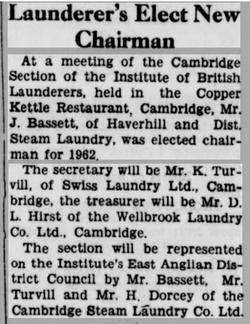 Haverhill Echo - Saturday 24 February 1962 - British Newspaper Archive. Haverhill Echo - Saturday 24 February 1962 - British Newspaper Archive.
In the same month of February 1962 Cambridge Steam Laundry changed its name and became the Cambridge Laundry and Cleaners Ltd with Mr Dorcey identified as the general manager. The company then takes over another laundry - The Coldham Model Laundry - bringing along a few of its staff.
1969
In August of 1969, the end of the 88-year history of Cambridge Steam Laundry was coming to an end. The name had been changed in recent years, but the business did not last much longer. The remaining premises and land were listed for sale by direction of Lyndale Laundries Ltd.
By October 1969 the public auction sale of the site had been withdrawn, citing the reason that the site had been sold by private treaty.
The mystery surrounding this sale was noted in a newspaper article the following year. It seems that after the private sale of the land in October 1969, the business had carried on for almost another year under its name of Cambridge Laundry and Cleaners Ltd, which had been owned by Mr W Shaw. It soon becomes apparent that the Swiss Laundry had taken over the Cambridge Laundry business. The Cambridge Steam Laundry, albeit with a new name change, finally closed for good on the site it had occupied for 89 years.
Today the Cambridge Steam Laundry Buildings are all gone and in their place is a new housing development called Brothers Place. Laundry Lane remains as a rough road now leading to a dead end.
You can download a PDF copy of Michelle's History of Cambridge Steam Laundry Company and Penny & Nicks article for free, by clicking on the buttons below.
Please do feel free to get in touch if you would like to add anything to this story or if you have any further information on the Cambridge Steam Laundry.
If you'd like to support the work that I do and the archive, why not buy me a virtual coffee or make a one-off donation at PayPal, I'd be really grateful and it will help keep me going! Just click on either of the buttons below :)
Suggested further reading and research:
Books that are worth reading on the subject: The Steam Laundry and its Methods - Charles A Royce How to Successfully Operate a Steam Laundry - Caleb David Patterson (Classic Reprint) The Steam Laundry. Its Construction, Equipment and Management - Taylor, John. (Consulting Laundry Engineer) LAUNDRY MANAGEMENT. A Handbook For Use In Private And Public Laundries - Editor of "The Laundry Journal" A Manual Of Modern Steam Laundry Work 1912 - Ellis Clayton Steam Laundries: Gender, Technology, and Work in the United States and Great Britain, 1880-1940 - By Arwen P.Mohun (Baltimore, Johns Hopkins University Press, 1999) Further Suggested Archives and Records to Consult: Cambridge University Library: Laundry books, 1956 - 1968 Reference Code: GBR/0265/UA/BG 18 Scope and Contents Record laundry taken in and money paid. Several of the books in this series were used concurrently. Dates: 1956 - 1968 Conditions Governing Access: From the Fonds: Among the archives of the Botanic Garden, personal records are closed to scholars for 80 years from the date of creation under data protection legislation. Restrictions are clearly indicated in catalogue entries. Found in: Cambridge University Library / GBR/0265/UA, Cambridge University Archives / Teaching, learning and research records / Archives of the Botanic Garden Personal diaries: Volume 39 (loose inserts), 1930 Reference Code: GBR/0271/GCPP Tillyard 1/1/39a Scope and Contents Photograph of AT with ? Agatha at St Anthony-in-Roseland in Cornwall; also press cutting re a carol concert given by the Perse School at the Cambridge Steam Laundry works. Dates: 1930 Found in: Girton College Archive / GBR/0271/GCPP, Personal Papers / Personal Papers of Aelfrida Tillyard / Personal and biographical records / Personal diaries, 1897-1959, together with documents formerly contained loose in the diaries, 1868-1959. Personal diaries: Volume 50, 1935-11-01 - 1936-06-08 Reference Code: GBR/0271/GCPP Tillyard 1/1/50 Scope and Contents Oxford. Still at St Benedict's. Alethea also living in Oxford - frequent visits. Brief visit to Cambridge - resigns directorship of the Cambridge Steam Laundry. Continued illness: goes to a nursing home in Torquay in Jan. 1936. March 1936 - has an operation then convalesces at the Convent of the Holy Trinity. Otherwise this volume contains largely description of the contemplative and religious life - occasional comment on the world, eg the situation in Germany. Discussions with Father Cary,... Dates: 1935-11-01 - 1936-06-08 Found in: Girton College Archive / GBR/0271/GCPP, Personal Papers / Personal Papers of Aelfrida Tillyard / Personal and biographical records / Personal diaries, 1897-1959, together with documents formerly contained loose in the diaries, 1868-1959. + taking on her father's role as a director of the Cambridge Steam Laundry Ltd. Writing: 'Concrete' and 'Can I be a Mystic?' both published by Tillyard, Aelfrida Cambridgeshire Collection: The laundry of perfection Author: Cambridge Steam Laundry Co. Ltd Imprint: n.d. Collation: 4 p. ; 19 cm. Dewey class: C.27.2 Local class: C.27.2 Language: English Subject: Cambridge Steam Laundry Co. Ltd BRN: 1144480 Cambridge steam laundry, 80 Regent St and adjoining shops Imprint: 1907-1911 (circa) Notes: Indexes: Yes Dewey class: P.Stea.K0 B.REG.K0 PC.Lan.K0 Local class: B.REG.K0 Language: English BRN: 1024081 The Cambridge Steam Laundry, Cherry Hinton Road, Cambridge Author: Sales Catalogue Imprint: Cambridge, 1969 Collation: p.7 ; 35 cm. Notes: With map enclosed Dewey class: C.06 CABINET Language: English Subject: Cherry Hinton Road
0 Comments
I came to Cambridge at the outbreak of the Second World War in September 1939 as a six-year-old boy, from New North Road, London, with my junior school from Islington. We walked around Cherry Hinton looking for people to take children into their houses. I ended up at a large house next to the Rosemary pub on Coldham’s Lane. My school was in Cherry Hinton at the green tin hut near the railway crossing. After a while, my lessons were moved into the school classroom from the hut. My playground places were the Spinney in Cherry Hinton and the chalk pits at Coldham’s Lane. One night during an air raid a high explosive, bomb hit Riche’s scrap yard killing the guard dog at the nearby cement works. I was standing in the road at the time when a bomb hit the cement works but didn’t explode. On another occasion, I was on Coldham’s Lane by the Rosemary pub when a German Dornier flew low over me on its way over Marshall’s airport. When America entered the war, many Americans came to Cambridge. They always had sweets to give to us children and the cement works road in Coldham’s Lane had conveys of trucks getting cement for their airfield runways. As the convoys were going into the cement works, I climbed in alongside the driver at the beginning of the cement works road, travelling with them whilst they collected the cement, and when the vehicle got back to Coldham’s Lane I got out. I always asked, “Have you got any gum chum?” They always had! When I was about nine years old, I joined the choir of Great St Mary’s Church in Cambridge, walking there and back for morning and evening services. One end of Marshall’s airfield was near to a field in Rosemary Lane. On a few occasions, my friend and I crawled through the barbed wire fencing to go up to the bombers to have a close look at them. After a few times of this, we were chased off by one of the guards, but it was good fun at the time. I spent a lot of days at Coldham’s swimming pool where I learned to swim. Coldham’s Common was covered in stone pillars to prevent German gliders or aircraft from landing. At the end of the war, I was eleven years old, and the children that I knew went back to London. When I saw my father and asked him about me going home, I was told he had no place to take me to. I then had to go to Cherry Hinton Children’s Home in Cherry Hinton Hall, with other evacuees and I attended Coleridge School. Cherry Hinton Hall was a grand old building with a stream running underneath the building and into the lake on the grounds of the Hall. It was a good place for boys as there were plenty of trees to climb and conkers to collect. There were five other boys of various ages, and I was the oldest. It was run by Miss Johnson. She was a very good lady at running the boy’s home. She treated us as her own. It had a bad reputation owing to older streetwise boys living in the hall and the headmaster of the secondary school would come to help Miss Johnson. On Coldham’s Lane, where the sweet shop used to be opposite Queen’s Meadow, I was with a young lad who had gone into the shop to get some sweets. An older, big boy, known to be a bully came over and hit my friend for no reason at all, and made him cry. I was having none of this, so I turned round and hit him on the chin knocking one of his teeth out. Being a typical bully, he ran home crying. He got his brothers to come after me on their way to school but I used to go around other ways to avoid them and they had to make sure they were not late for school, so they never got me. The village boys didn’t realise how streetwise we London boys were. Next to the Hall was an Italian prisoner-of-war camp, on Walpole Road. I spent a lot of time in their camp talking to them as some could speak a little English and they made toys for us. After about two years of being at Cherry Hinton Hall, we were told it was going to close as a children’s home and the boys were told we would be going to the Red House children’s home at Little Shelford. This was a sad day for the boys who had nowhere else to live. On the day we left Cherry Hinton, I, being the eldest, took the boys to the pictures in Cambridge. Then we had to catch the bus to Shelford and then to the children’s home. It was a large house with many rooms and a very large garden with a brook running down one side. The bad reputation of the boys from Cherry Hinton Hall during the war had reached the children’s home in Shelford. One day, when my friend David and I were talking to two of the village girls who were on the other side of the stream, a man called out to them. “You don’t want to talk to them. They go round with a ball and chain on their feet”. So, the bad reputation of Cherry Hinton Hall during wartime had preceded us. But we changed their minds when they got to know us. I even played football for Shelford. Having moved to Shelford I still went to Coleridge School, until I left at the age of fifteen. The council then found me lodgings in Cambridge. I was then working as a printer in Cambridge. The third lodgings the council found me turned out to be two doors away from my future wife Doreen. She was fourteen at the time and I was sixteen. We were together for seventy-two years, until her death in January 2022. When I was eighteen, I was called up for the army. After several weeks of intense training, I became a paratrooper and joined Two Para serving in Egypt, Cyprus, and Transjordan. When I left the army, I went back to my job as a printer. Doreen and I got married, I was twenty-two and she was twenty. We had three children, all boys. Two were twins and an older brother by three years. I later joined the Royal British Legion at Waterbeach and, after a few years of training, became their Standard bearer. I entered competitions and became the county Standard bearer a position I held for a number of years. It was when my wife and I went to a function on The Green at Waterbeach that I noticed there were several ex-paras there with a stall selling various items including military badges and other items of interest. They asked me if I would join the Cambridge branch of the Para Association, which I did. It was a very active branch which organized trips to Arnhem every other year. I eventually carried the branch Standard to the events at Arnhem and other places in the U.K. At the age of seventy-two, I became the Para Association National Standard bearer. The Standard is the only Standard of the Para Association that has a Union Jack in the top corner. About a year later the Standard was being ‘laid up’ and I was to receive the honour of carrying the new one, at the event where it was to be dedicated at a church in Normandy. At one of the Normandy events, a bust of Major Jack Watson was to be unveiled by Prince Charles (as he was before becoming King). I asked him if he was doing the unveiling as I had the National Standard with me. He told me to bring it over and when telling my superiors of this they replied that they couldn’t overrule his wishes. In my seventeen years as the National Standard bearer, I carried the Standard every year to the Ardens, Rhine Crossing, Belgium, Normandy, and Arnhem. I would like to pay a special tribute to my wife Doreen who accompanied me on all my duties, at home and abroad. Without her support, I am sure I would not have carried on for as long as I did. I would also like to thank the Watson family, the Zannette family whose father was a Normandy veteran, Ralph, who organised all the trips, and Barry our bugler of many years. Jane and Elaine Zannette are still very much in contact with me. I go to Kent to stay with them for a few days and they come up to stay with me. They also ring me to make sure I am okay. Ken Price 2023 Many thanks to Patricia Curry for helping Ken write up his memories. You can download a PDF copy of the original article by clicking on the button below.
Here you will find the complete contents of Cherry Hinton Memories Book Three - if you haven't done so already, I would encourage you to take a brief look at the introduction page about these books first - which you can do by clicking the link here: Cherry Hinton Memory Books - Introduction
There are three books altogether and one separately written story - you can find the links to the other books and story by visiting the Cherry Hinton Memory Books Introduction page, mentioned above, or by searching the index (Categories) on the righthand side of this page or by using the search box on the right.
BOOK THREE
Book Three “The Golden Years - Cherry Hinton, 1930's-1960's"
Contains memories from: Unknown Christine Wright Mavee Williams Malcolm Jobson Bett Dawson Stuart Nunn Neville Cullup Basil Simpkins Tony Tabor David Gifford Kenneth Gifford
Below you will find the full transcription of book three, copied as it is, with pictures of the handwritten stories to compare (and send me any corrections!). You can choose to read through it here or, for more detail, you can click on one of the names above to see their story individually and any extra pictures that I have added to illustrate their story.
Book 3 The Golden Years Cherry Hinton 1930's-1960's.
Unknown: Cherry Hinton Memories
I was born in the middle of the night in February 1944, in a council house up Fulbourn Road beside the Spinney and at the other end was a big Dutch barn, both the Spinney and the Dutch barn were ideal for children to play in. The council houses at Fulbourn Road were the latest in Cherry Hinton, completed in 1939. They had flushing toilets, a luxury that not everyone enjoyed in England during the 1940’s. I recall in my pre-school days the High Street was not made up and not kerbed all the way from the Robin Hood corner to the school – which was opposite Ling’s sweet shop. We could drink the water from the natural spring opposite the Robin Hood where wild Honeysuckle grew and Moorhens nested on the island. There was a green triangle that made the slip road from Queen Edith's way to Cherry Hinton Road and Mr Scott, who lived in the first house by the Spinney in Queen Ediths Way used to hold Sunday service for the young men of the parish. There were two thatched cottages in the corner of the Spinney opposite the Robin Hood where the late Bricky Mason used to live in one. Turkeys often wandered along the High Street from Stevens Builders Yard where they were being fattened up for Christmas (meat was on ration). In the late 1940’s for pre-school children Cherry Hinton was idyllic with the war over. We had the Spinney, the Recreation Ground, Cherry Hinton Hall, the chalk pits and lime pits, with only the chalk pits still being worked of these – we could roam free all over the village. Fulbourn Road in the late forties and early fifties was home to lots of children. The games we played too numerous to remember all. The council house side was on a sub-road with only one entrance for cars, you could draw anything on the road and play. There were several variations of hop-scotch and with the Spinney and chalk pits nearby there was no shortage of chalk. I recall the game with the most competitive edge, passion, and arguments, that lasted days or until the next time all the children were available for a re-match was rounders – “boys against girls a catch was the whole side out”. On the Recreation Ground then half the size it is now, as Bullard’s Brewery owned the Chequers and allotments behind it, there was Sid Hancock’s bungalow – the village cobbler. The old British Legion “Hut” as the locals called it was a long, mainly wooden structure built on raised concrete stilts, therefore small children could easily move underneath it. The Rec in those days had lots of bushes around it and small copses of trees more natural and evolved than the well organised and designed as today – but much more fun for children. On V.E. day in May 1945 Fulbourn Road children had a celebration party under the Dutch barn. In the late 40’s and early 50’s on a Saturday morning and early arrival was Mr Hardwick who came down the Fulbourn Road with a horse and cart, it was a mobile shop. A thatched cottage caught fire on Saturday morning in the High Street 1955 and the Esso Garage and Petrol Station were built there.
Christine Wright nee Ellison Cherry Hinton Memories 12 Nov 2012
Cherry Hinton in the 50’s & 60’s was very special. I know everyone will say that about their village but it is true. Bert Quinney’s shop – he could serve 10 people at once as he knew who came in for cigarettes & what brand, he knew who paid cash and who had “tick”. I am sure he was the shopkeeper who “Open All Hours” character “Arkwright” was based on. Pledges newsagent in Coldhams Lane used to sell comics which were out of date much cheaper. I used to love going there to get “Bunty”. Greenwoods sweet shop near the railway was so small. In the 70’s Mrs Greenwood used to do chiropody. Our Sunday “paper boy” was Jim Chapman – bringing us the News of the World. We lived in the prefabs in Teversham Drift which were lovely & warm until 1964 when we had to move to Fulbourn Road as they were going to be demolished. The house in Fulbourn Road was a shock as there was an outside toilet & ice on the inside of the windows! Cherry Hinton Infants School with Mrs Holman as Headmistress. She showed my mum (Tess) the drawing I had done titled ‘what I did on a Sunday morning’. It was a picture of my friend Valerie Betts and I playing in the garden of the Red Lion while my mum was inside having a drink. All the other pictures were of children going to Sunday School, going to nana’s, taking the dog for a walk etc. Well, she always told me to tell the truth! Miss Rush riding her ‘sit up & beg’ bike across the playground & all the children jumping out of the way convinced she would run them over. Was there a child in Cherry Hinton who was not frightened of her??? Colville School with Mr Farmer as Headmaster. Being milk monitor & carrying the crates on a cold icy morning & the milk had frozen forcing the top of the bottle was a highlight. Playing tig off ground in the girls toilets & being sent to Mr Farmer for the steel ruler treatment. Daren’t tell my mum otherwise I would have got another clout when I got home. Many, many memories. Christine Wright nee Ellison
Maree Williams nee Stevens Cherry Hinton Memories Nov 2012
My sister and I were born in the front room of Fulbourn Road in 1944, and I lived there until I got married. Growing up in Cherry Hinton was childhood heaven, we spent most of our time playing outside in the road, the Spinney, down the Rec and in the big barn at the end of our road and round the back of the houses there were allotments, no buildings then. My father kept pigs and chickens and Roy Tabor had a shepherd’s hut on his. My father used to walk the sows all the way down the High Street to Mr Fabbs pigs opposite the church. We knew mostly all the neighbours, Tabors, Grays, Chapman, Walders, Clarke, Pearson. We would start building a bonfire weeks before Nov all the road contributing and on Nov 5th used to go with our potatoes. No fancy fireworks then – bangers, rockets, Catherine wheels. We would try and keep embers going for days. We used to be sent to shop in Smiths. – on the bk, and George Parish the butchers used to have a bike with a huge basket on the front, smoking and coughing his heart out, then there was Arkright himself – Bert Quinney with his brown coat on. Love Lane was another haunt there was a scrummy pear tree in the middle of the field ideal for scrumping, messing about down the island and falling in trying to get to the middle, playing in the buttercup field opposite the Spinney, doing a paper round on the new estate after collecting the papers from Jim Chapman in Coldhams Lane We used to walk round from school once a week for country dancing, a lady used to play the accordion, and many happy times spent in the Tin Hut, it looks a bit worse for wear now. We also had lots of dancing etc. in the British Legion Hall down Fishers Lane, mostly every week there were live groups, rock, roll and skittle, Mark Arnold and Jonny Collum absolutely packed, great, happy times.
Malcolm Jobson Cherry Hinton Memories – 20/12/2012 – 75 High Street (after Giffords)
My family, the Jobson’s, mum Mary, dad Tom, Michael, Margaret, Alan and Brian, arrived in Cherryhinton in the early 1950’s from Radwinter End near Saffron Walden. We lived at number 75 High Street in a tied semi-detached home which belonged to the farm owned by Mr Chalk, where my dad worked as a famer. Mr Chalk was also an auctioneer at the cattle market which is now the industrial site at the top of Cherry Hinton Road near the railway. After Mr Chalk died, the farm and the field were sold and now is the Chelwood Road estate behind Rectory Terrace on the High Street. We later moved onto the Colville Road estate to live at No. 10 Drayton Close, my dad still lives there today with my brother Alan. Going back to the house on the High Street, behind there was a builders yard owned by Mr Stevens who had a son called David whom I played games with. He had a elder brother who played football for Cherryhinton F.C. I had another mate named Peter Anderson who lived in Fishers Lane near the little chapel, we all used to go on the bus with the football team to away matches on Saturday afternoons. Some player’s I remember in the team were, Brian Stevens, Peter Dean, Billy Chapman, Mick Colville, Sam Bartrum, Ron Hagerty, to name a few, and the manager was a Mr Denny who lived in Queen Edith’s Way. Opposite our house, and still there today is a little thatched cottage where Mrs Jane Elwood lived, a lovely old lady who used to give us children sweets and drink (orangeade). Behind her house was a field which someone used to keep a little pony, and every weekend a male patient from Fulbourn Hospital used to bring a carrot to feed it. We named him Pony Man. The site now belongs to Tony Mason Plastic Engineers. To the left side of our home was a big white cottage and when the wife died the gentleman had it burnt down, and he went to live in a caravan in in the orchard at the bottom of his garden. My friend Peter’s mum used to work as a cleaner at the big house in the middle of Cherry Hinton Hall grounds. At that time it was used as a play group, and one day, when his mum was there working she let us go down into the cellars which are still there today. It now belongs to Cambridge City Council who hire it out. At the back is a large playing field. When myself and Peter came out of Netherhall School we used to kick a tennis ball to each other on our way home. Later when we were in our teens we met up with a lot more youngsters and we formed a Sunday football team which was called Hinton Rangers F.C. and we became the first team to win the newly formed league by one of our lads named Bruce Badcock and someone from the Cambridge newspaper. I remember we all met round Mick Davey’s house near Queen Ediths School to pick the name of the club and the all-green kit we played in by a show of our hands. At the top of Fishers Lane on the High Street now stands a Guest House, before it was a home to Mr West who owned the Renault Garage at the top of Coldhams Lane near the traffic lights. They also had a son called Martin who used to let me and Peter play snooker on his father’s table. The little hut in the picture with the lamp post outside in Mrs William’s Story was a classroom for the infants school which I had when I went there. We all loved Cherryhinton village as it was then, we knew a lot of people, who looked after the little ones, watched it grow to what it is now, no longer a village, but a part of the City. By: Malcolm Jobson.
Bett Dawson (nee Stevens) Cherry Hinton Memories
In February 1938 we moved from a farmhouse in Shelford Bottom to the new council house in Fulbourn Road Cherry Hinton. My mum and dad and two brothers Peter and John, and my sister Pam. I was 9 years old. We thought we were in heaven, bathroom, hot and cold water, flush toilet (even though it was outside). We all went to the school in the High Street, Mr Bray was the headmaster, the times I’ve stood on a chair and was hit on the back of my legs with a ruler. We spent holiday playing marbles in the street and hopscotch. My father was in the T.A. and went straight in the army when war was declared. During the war there was dances every Saturday in the Legion hut on the Rec, you could hardly move let alone dance it was so crowded, especially when the pubs closed. We used to sit on the bank and watch the army convoys going down Fulbourn Road, on one such convoy there was a fatal accident near Fulbourn Hospital, my father built an air raid shelter in the garden but we rarely used it, it was much better to get under the table when the sirens went. Then we had the evacuees form London, the brightened things up. One or two families stayed in the village after the war. In 1947 the weather was very bad, we had lots of snow, my brother Pete and I had to get in the loft and shovel snow out, the inside of the windows were iced over and you can guess what it was like getting up in the morning and walking on cold lino. Over the years, whenever I’ve been, I’ve always come back to Cherry Hinton it was a lovely place to live, and I’m still living in Fulbourn Road. Bett Dawson (Nee Stevens)
Stuart Nunn Cherry Hinton Memories 04/02/14
I was born on 27th April 1951 to Jim and Joyce Nunn (nee Elliot) and we initially lived in a room on Fulbourn Road next door to the Plumbs. Mum was the daughter of Kathleen and Bill Elliot who lived in Fishers Lane. Bill worked at the cement works and spent a lot of time at the Five Bells in the High Street and I remember on one occasion he fell off his bicycle attempting to get home after a session in the pub. Her mother also lived in Fishers Lane and I believe the family history goes back many years before that. Around the age of about 3 mum and dad got themselves a council house in Drayton Road, dad spent most of his time on the allotment and playing football for Cherry Hinton who were a very successful team in those days. I can remember as a young lad going football training with dad at Stevens Farm in Teversham and I think we were one of the few teams that had floodlight facilities for training. We used to watch the Cherries on the Rec and in the mid 50’s they won the premier division of the Cambs league and I recall seeing such people as Brian Stevens, Peter Dean, Billy Chapman in the team. I remember Mr Rust the hairdresser as one of the driving forces. I used to go to the 27th Cubs at the red hut on the railway line and always went to Auntie Nelly and Uncle Charlie Mason who lived in Railway Street for my tea on a Thursday. Their daughter Ann would always make sure that my ears were clean and that my hands were not dirty before attending Cubs. When I visited Aunty Nelly and Uncle Charlie I used to play with their son Tony who used to shoot birds in the garden with his air rifle and I had the most enjoyable times playing with him. Mum and dad were regulars at the Unicorn where they played both skittles and darts and I can remember as a young boy sitting in the garden eating my crisps and glass of lemonade, the landlord being Reg and Daisy Fuller who would be always bickering with each other but the pub was very much community orientated with lots of Cherry Hinton people enjoying themselves. I used to go shopping with mum at the co-op and was fascinated to see the money shooting around the tubes when she paid for goods. Gran had her groceries delivered from Bowyers but unfortunately their demise came in the late 60’s. In my early teens my friends and myself used to visit Bob Hirsts fish and chip shop in the High Street who used to sell marvellous pickled onions and would always give you a bag full of fritters when you bought your chips. Mum and dad then bought their first house in Claygate Road, Cherry Hinton for I believe in the region of £3,000 and I was lucky to pass the 11 plus and caught the bus from the High Street to Soham Grammar School on a daily basis. When I was 16 dad encouraged me to join Cherry Hinton Football Club and I can remember dear old Bunny Tabor finding it difficult to keep up to date with play acting as a linesman. I was lucky enough to achieve first team recognition and a small amount of success was forthcoming. Most of the players came from Cherry Hinton such as Trevor Chapman, Tony Tabor, Paul Ritson, Barry Witt, Mick Colville, and the rest I just cannot remember. A lot of my early years was football orientated and I can remember in the school holidays spending virtually all my spare time playing football on the Rec. The only other activity on the Rec or near the Rec scrumping in the apple trees in the orchard which backed onto the Rec and we were only caught on one occasion and my god whoever hit us, hit us hard with a very large stick. I think that covers the 50’s and 60’s and my recognition of what was then a great village to live in and I have not lived in Cherry Hinton since my early 20’s and am now semi retired living near to the Suffolk coast. Mum died some 12 years ago and dad recently passed away on 9th December 2013. We have now sold the family house and I must say Cherry Hinton has changed so much, not for the better but I still have very fond memories of my early years. Stuart Nunn 04/02/14
Nev Cullup Cherry Hinton Memories
I was born on 1st October 1936 at 6 Railway Street, Cherry Hinton in the front bedroom that looked out onto the cement works. Next door but one to my friend Tony Mason and his sister Ann. My father Bert Cullup and mother Daisy had moved with my sister June from Fishers Lane to look after my grandfather Jim Fisher who worked for Pamplins Agricultural Engineers as a foreman driving threshing and ploughing steam engines. He was well known as the Steam Engine Man. During the war I remember my father was a nightwatchman for Thompson’s Yard in the High Street. He dug an enormous hole in the back garden, then bought a large car body from Richies in Coldhams Lane and put it in the hole with steps down to the door and covered over with railway sleepers and earth. When the sirens sounded we all got into the home made shelter together with our neighbours from number 4 the Stevens. However my grandfather Fisher refused to leave his bed. I can remember bombs dropping over the railway line in a field close to Orchard Estate. One dropped through the roof of the cement works but failed to explode. However the one that fell on Riches Yard killed his guard dog. I can distinctly remember, even now, the sound of the Doddlebugs as they went overhead. I remember my grandfather James Fisher cycling to nearby villages as foreman to oversee the ploughing and threshing engines from Pamplins who lived in ‘The Battlements’ in Fernlea Close. Nearer to home I can recall at least 4 stacks waiting to be threshed at the end of Fishers Lane which was then an unmade road. The smell and heat from these mighty steam engines that remains with me to this day. Also in Fisher Lane on the right Ray Cawston’s father George kept pigs. He also operated a mobile greengrocery van with his wife Gladys. I remember coal being delivered to the school in the High Street through a sort of trap door in the wall to fire the tortoiseshell stove in the Parish Room (Green Hut) and the open fires in the classrooms. These were tended by the school caretaker Harold Fabb. On cold days in the winter the third pints of milk would be stood around these fires to warm – no ‘health and safety’ then. Regarding memories of the school, I remember a sliding partition between Miss Wilson’s and Miss Rush’s classes which was folded back nearing Christmas to facilitate the playing of numerous simple but enjoyable games. Hester Anderson from Fishers Lane was the school cleaner. A large bell hung in an archway on the roof over the top of the school office with a rope hanging down into the hall. Perhaps somebody will recall it ringing? Owen Fabb was a friend and his father Harold kept pigs and one cow in a field beside Fulbourn Old Drift. During the summer holidays when I was 9, Owen and I hoed almost a whole field of sugar beet. Harold gave me a suckling pig which I took home in a home-made wheelbarrow, to a sty in the garden. I called the pig Marco Polo as we were studying the adventures of Marco Polo in Miss Lilley’s class. One Saturday morning I remember Harold wanted to get the cow out from its stall. He tied a rope to her halter and round his waist. After some considerable pulling and swearing the cow bolted pulling Harold halfway across the field with both ending up in a ditch much to my and Owen’s amusement. When I was 10 years old I developed a TB hip and was sent to a hospital in Shropshire. The school P.T.A. sent me 2 books and Sylvia Horner sent me comics. My own mother wrote to me every day, including Sundays for 5 years, she also sent food parcels twice a week because the hospital food, before the NHS, was quite awful. Five years later, after an operation, when I returned home, most of my contemporaries had finished secondary school. I learned to walk again, then Mick Bentley and I made a table tennis table in a large shed in Steven’s Builders Yard in the High Street. We hired the Parish Room (Green Hut) and started a table tennis club. Among the members I remember were Ken Harrison, Fred Rentcomb, Peter Tyrrell, Peter Dean, Peter and Michael Boland and some local girls. We met most Friday nights and entered a good team in the Cambridge League for several years. Opposite the Parish Room (Green Hut) in 1956 Lings shop was bought by Ted and Audrey Cunningham with their young daughter Sally. They introduced me to their niece Janet then 16 who I married in 1959. That same year I bought the bungalow and show repair business from Sid Hancock after working for him for 7 years. I continued the business until April 2013. These are just a few of my memories of a Cherry Hinton childhood – perhaps I should write a book!
Basil Simpkins Cherry Hinton Memories Nov 2014
I was born 31st Jan 1941 at 36 Mill End Road, the youngest child of Ralph & Irene. I had two older sisters Daphne & Beryl, who have both sadly passed away. I remember the blacksmith at the top of the road and Chalks Farm at the bottom. One incident I have always remembered was when my mum cycled by the brook through to Mill Road with me on the front I pointed to a Barrage Balloon in the sky & we both ended up in the water! I remember seeing the ration books hanging on the line to dry out. Before I started school I played with Susan Thompson, who lived next door. I learnt that it’s not a good idea to chase women after chasing her round her rockery and cracking my head on a rock! When I started school in the village I was in Miss Wilson’s class and we drew on little chalk boards. At the end of the day the children who had been good had a turn on the rocking boat. I then went to Miss Rush where I peaked and was top of the class (the only time!). I remember the start chart with the times tables on it and instruments mentioned by Chris Gifford. In Miss Dunnett’s class I think we made made models with Homerton students. I enjoyed playing football and cricket in Mr Read’s class. I passed the 11 plus and went to the Central School with Chris Gifford, Dicky Pilsworth and ? Stevens. Tony Mason went to the “County”. I had happy years there, especially enjoying chess, football & cricket and maths. At Cherry Hinton School I also remember country dancing with Mr North. We did a display on Sports Day and I danced with Doreen Fabb. Around the village I remember playing on the Rec. with Tony & Brian Tabor, Peter & Michael Boland, John & Peter Hedge, John Cornell, Chris Gifford, Brian Grey, Billy Taylor & others. There was a track at the top of the Rec. for riding bikes between the trees. Ray Causton had the best bike. Billy Taylor would take his air pistol & rifle up there and if we were lucky he let us have a go. We played in the brook – building dams and fishing for sticklebacks. My sister and I would go through Cherry Hinton Hall grounds across the wall at the lake, around the springs and into the High Street. I was not allowed to go in the Spinney but of course I did! We loved building dens, making fires and playing “offs”. I remember bikes being ridden up and down the hills. I once borrowed Chris Gifford’s bike (I didn’t have one), came off halfway down, Brian Tabor came behind and his pedal hit my eye. I told my parents I had fallen over on the Rec & hit my eye on a brick! I had a black eye for ages. In the hard winter of 1947 I remember we went into the field at Fishers Lane where there were icy pools. Margaret Boland was the first to run across the ice, making it crack! I joined the Cubs in 1949 and loved the Cubs and Scouts, with Mr Ward the Scout Master. We had summer camps at Pakefield and Cromer and weekends at Pampisford Hall. We went in the back of Steven’s lorry. One Bob-a-Job I remember making sausages for George Parish the butcher with Michael Boland – very unhygienic! During the holidays we would go out on all-day cycle rides, sometimes Newmarket or Royston. I must have been impressed with Royston because when I married in 1966 I moved there and have lived there ever since! Tony Tabor also married that year. We have remained good friends and meet up regularly – often reliving happy childhood memories of Cherry Hinton.
Tony Tabor Cherry Hinton Memories Jan 2015
Sorry, my memory is not good!! I lived in the Chequers Public House on the High Street, Cherry Hinton with my mum Nellie, dad Jesse and brother Brian. I remember going to school with Basil Simpkins, Chris Gifford, Bill Taylor, Brain Gray, also Peter and Mick Boland. I also remember the butcher George Parish and also the shoe mender Sid Hancock (that was before Nev Cullup took over the business). We had an Anderson bomb shelter in the back garden of the Chequers and Brian and I would play in and around it, I remember one of us fell down the shaft and hurt ourselves badly, but I can’t remember which one of us it was!! Our father had a newspaper business and we would go with him very early in the morning to collect the papers from the train station, then we would help to deliver them around Cherry Hinton houses. When we were old enough we both helped mum and dad by serving in the Pub behind the bar, there were lots of great characters – Bags Chapman, Cyril Murrell. Wonderful memories.
David Gifford Cherry Hinton Memories – Ex – 75 High Street. Opposite to the Thatched Cottage. June 2018.
We went to school one day, and found some tyres in the playground. They were for a race on Sports Day. A boy was to sit inside the tyre, and another boy to push it along. Billy Taylor asked me to sit inside a tyre. When the race started, Billy gave a really big push, and away went the tyre over the finishing line, and continued until I think somebody stopped the tyre. When I looked back, I was the only one over the finishing line, thanks to Billy. When I first went to school, I played with the bigger boys. One day a boy called me toddler, so I ran after him to hit him. All of the boys began to call me toddler, which after a time shortened to Todd. So Todd I was throughout my life. When I was about seven years old, we were told about Cave Men at school, and I thought that I would like a Cave. So I took a spade and fork down to the bottom of our garden, next to Mill End Close. I began to dig a hole. Soon, some boys came by, and asked me what I was doing. When I told them, they came into my garden to help. More boys came by, and they helped too. But then I put the fork into my foot. It hurt, so I got out of the hole. By this time there were too many boys to dig. So some of them went onto the Playing Field (Rec). They returned with sticks and green plants to put over the deep hole. They had just finished, when my mother came to see what we were doing. She was not happy at all. Some of the gang had gone into Mill End Close. My mother was telling them off; when she stepped back onto the roof of our hole, which gave way, and she fell in. The gang ran off to the Playing Field, but I couldn’t run as my foot hurt so much. I didn’t know that my mother could speak a foreign language. I didn’t understand one word, but I knew that I was in for it when she got out of our hole. Yes we had a great childhood. They were happy days, but sadness too. After some years, I went to C.H. High Street. I knew that it was just before John Cornell’s 50th birthday. So I bought a card, and gave it to his mother to post. Some weeks later, he phoned me, and that was great. He said that he would look me up, but it didn’t happen. That year I was told that he had died on the way home from work. Only 50 years old. I have had a good life. I became a Christian in my teens. I live near St. David’s in Wales, which is not much bigger than Cherry Hinton in the 1940’s. I can look out of a window and see a line of hills two miles away, and the sea in another direction. It is great! Todd.
Kenneth Gifford (Kenny) Cherry Hinton Memories 2/04/2020
Hi, My name is Kenneth Gifford (Kenny). I’m the youngest brother of three, Chris and David (Todd). Mother “Dot” and dad “Sid”. We have lived in the forties and fifties in the oldest house in Cherry Hinton High Street opposite the old Chequers Pub run by the Tabors. A big Tudor house with a large garden which went right down to Mill End Close where a lot of our friends lived. My first recollection of growing up in Cherry Hinton was sitting on a little seat on my mother’s bicycle at the age of three and half going to pick potatoes in the large field running down the side of Fulbourn Old Drift opposite the parish church. The church where I was nearly stopped for going because I would not sit quietly. Like others, we also all went to the Baptist Church where I remember the Smith sisters would be teaching in Sunday School. Owners of the lovely little grocery shop near Roots Bakery. The school has already been mentioned by others, I can only add that it holds some of my happiest memories. Mr Farmer and my form teacher Mrs Rush, I can still remember running home to tell mum and dad that Mrs Rush had given me the “ruler” across both calves for being cheeky. Me!! I remember one school Nativity play, the school hall was packed, people standing at the back and sides and four young boys were shepherds in the field looking after their sheep. Itchy blankets, tea towel on the head, sitting around a pretend fire. I only had one line “The star is very bright”. This unfortunately came out as “Cor Blimey me, it ain’t half bright in’t!!” My mother took days before she would leave the house. Someone said “A star was born”. The games of conkers and marbles played in the playground were legendary. We always collected an abundance of conkers from the conker trees on our way to school. During September, just past Lover’s Lane was the farmers field which had a very large walnut tree. Iron Railings right along the path with just one bent railing just enough to squeeze through!! But there was always a very large unfriendly white horse just waiting for us. So with carrots in one hand one of the boys would try to lure the beast to the other end of the field, many a times I would just make it back through the railing!! The Rec was another source of fun. Crawling under the British Legion Hut just behind the cobblers bungalow, especially when the dances were being held. We would watch our hero’s playing football during the winter and cricket during the summer. I never thought that I would receive a telephone call in 1962 from Joe Denny asking me to cycle to the Abbey Stadium as three of the first team forwards were either injured or unavailable to play against Girton in the Creake Shield Final. A dream first half saw me scoring the first and third goal in a 6-2 win, followed by my first beer back at the Chequers Pub with the men. My dad was so proud but it put me off beer for life!! Behind the trees at the far end of the rec was a very large corn field where we would run through trying to find the skylarks nests, to no avail. Who can remember the time during the forties when the army put on a show on the rec with all their equipment/guns etc and letting off canisters of “smoke screen” for us youngest to get lost in. As somebody has already mentioned the freedom which we enjoyed during this time. Half penny bread rolls hot from the baker before spending most of the days in the “Spinney” playing “offs” and later riding our bikes up and down the big hills. I also remember always going to the Spinney to pick wild violets and primroses on Mothering Sunday for our dear mothers. We built our own trollys and sledges for the mad rides down Lime Kiln Hill during the winter and summer. How we all reached adulthood I never know. I nearly forgot about the snail races on the front path outside our house and the time in our back garden when about six/eight of us dug a large and deep hole to reach Australia. One evening my mother returning from the Chequers after playing in the ladies Darts team managed to fall right down in the hole. I learnt some of my first swear words that evening. Dear dad had to climb down to recue her. Needless to say the hole was gone the following day. Like others I’m now in my seventies but I can still look back and say “What a great time to be born and spend my early childhood in such a wonder village as Cherry Hinton” I now live in Comberton. Kenny Gifford.
If you'd like to support the work that I do and the archive, why not buy me a virtual coffee, I'd be really grateful and it will help keep me going!
Just click on the green button below :)
Here you will find the complete contents of Cherry Hinton Memories Book Two - if you haven't done so already, I would encourage you to take a brief look at the introduction page about these books first - which you can do by clicking the link here: Cherry Hinton Memory Books - Introduction
There are three books altogether and one separately written story - you can find the links to the other books and story by visiting the Cherry Hinton Memory Books Introduction page, mentioned above, or by searching the index (Categories) on the righthand side of this page or by using the search box on the right.
BOOK TWO
Book Two “The Cherry Hinton Gang” Those Golden Years
Contains memories from: Bryan Stevens June Stevens Pat Clarke Julie Smith
Below you will find the full transcription of book two, copied as it is, with pictures of the handwritten stories to compare (and send me any corrections!). You can choose to read through it here or, for more detail, you can click on one of the names above to see their story individually and any extra pictures that I have added to illustrate their story.
Book 2 “The Cherry Hinton Gangs” Those Golden Years.
Memories of Cherry Hinton by Bryan Stevens
Vic Phillips often mentions me by my nickname “Ziggy”. Ziggy was the owner of the clothes shop in Newmarket Road before he moved into Regent Street “Stylebest”. This shop sold the most modern clothing during the fifties and sixties and it was where I bought most of my clothing, hence the name “Ziggy”. Ziggy gave me a gold tie pin for my wedding in 1959 which I still have. I am now happily married for the second time. Bonfire nights in the High Street were something special. There was an air raid shelter opposite 197 High Street, where I used to live, and we would fill it up with logs collected from the Spinney. One Bonfire night the fire was so large that it nearly burnt down the telephone wires. There was a rubbish dump down Fulbourn Old Drift over the railway line and we would go up there with our air rifles to shoot the rats. One day we were up there shooting the rats when the siren sounded from Fulbourn Hospital and thinking someone had escaped we all ran home as fast as we could. We all talk about the Spinney with fond memories. During the school summer holidays we more or less lived up there, making dens, laying turf for the floor of the den, and cooking on open fires. One day when we were there my dog Gyp caught two rabbits from out of the chalk pits which I took home. Opposite the Robin Hood pub are the springs where the water for the brook starts. There used to be railings round the springs to try and keep us out but we would get in and try to catch the pike which would be by the island. We would stand on the now stepping stones and try to catch them before they went back to the lake in Cherry Hinton Hall. In the brook round by the Black Land allotments we would block up the tunnel underneath the bridge with a sheet of corrugated iron so that the water could not escape and we could get it deep enough to swim. Grandma Coe who used to live at the then 203 High Street was still riding her “sit up and beg” bike when she was 90 years old. I still remember when a horse and cart passed by her house and left “deposits”, she would rush out with a bucket and collect them. She always had the best roses in the High Street. As you old Hintonians know, my grandfather started the Stevens Brothers Building Company. He built some of the first houses for the Housing Association in Cambridge. One of the last houses they built was the bungalow in the High Street for the Bartram family (the level crossing keepers). They also built the shoe repairers bungalow next to the recreation ground. The Cherry Hinton History Society have no record of the building company. My only record is a photograph of a cast iron sewage drain cover in the front garden of the house in the High Street which used to be 201 High Street. It reads “Stevens Bros, Builders, Cherry Hinton”. If anyone could help me find out any other information I would be grateful. For the version of this story with pictures and added notes, please click HERE
June Kathleen Stevens (nee Buffett) Cherry Hinton Memories
I was born on Friday 13th June 1930 at 39, High Street, Cherry Hinton in my grandmothers little thatched cottage which sadly no longer exists as all three were demolished to make way for shops. We were fortunate to have a general store and post office next door – Mansfield’s. Mr Mansfield was also our landlord. We had no gas, electricity or water in the cottage; cooking was done in the oven heated by the fire (which was never allowed to go out) or on a small paraffin stove. Water was collected in pails from the pump in the road outside Mansfield’s, in later days a tap was installed in the next door cottage garden. I don’t remember the name of the lady who lived there but the Fuller family lived in the one adjacent to grans. Fred Fuller spent many years driving what was called ‘the clunch waggon’ from the chalk pits up to the cement works, back and forth many times a day. The water carrying was a chore mostly carried out by the man of the house – in later years my boyfriend came in handy for the job! Grandad (Albert Buffett) was a road worker in his prime but after retirement I can remember him smoking his pipe, leaning on the gate at the top of the path and watching the world go by. The gate and railings were taken for the war effort but Grandad died in 1938 so didn’t miss them. At one time, he had an allotment round on ‘the black land’ and very productive it was. As a special treat, I was ferried there on the crossbar of his bike. Gran (Elizabeth Buffett, nee Clarke, whose father owned the bakery and store in Weston Colville) remained in the cottage for many years and I lived with her after we had relocated back to Cambridge from Norwich in 1946. My dad, Noel Eric Buffett, moved back to take over running the Self Motoring Garage on Hills Road. In his youth he was a milkman delivering by horse and dairy float in the village. This mode of transport soon became too slow, so he decided to be adventurous and started up a taxi service. I still have his first driving licence dated August 1922, he was 19! The service became quite popular, the local builders, Stevens Bros hired him every year to take them to Yarmouth for their day out at the races, I particularly know of this event as I am married to Bert Stevens’ second son Roger and the tales were told many times by Roger’s grandad. As teenagers we had a great time in dear old Cherry Hinton, the Rec being a favourite meeting place. The village had the usual celebrations at the Queen’s coronation, I Particularly remember the football match on the Rec – girls versus boys. I believe the girls won although we had a distinct advantage – the boys had their hands tied behind their backs! My good friend Joyce Elliot was a major player in our team and gave no quarter!! We also had the run of the Spinney, fishing for tiddlers down the ‘island’ opposite the Robin Hood and bike races down Lime Kiln Hill which would be very much frowned on by health and safety these days. How surprising that we al survived (Joey Ling did break his arm once!) Roger has just reminded me of when he played football in the field at the top of Fishers Lane – before the game, everyone was required to remove the cow pats! A wonderful ‘growing up’ time in Cherry Hinton, writing this has made me recall so many things, the book is a great idea, long may it continue. Regards to all who may remember me – June Kathleen Stevens (nee Buffett).
Pat Clarke Cherry Hinton Memories 3-9-12
My memories as a kid in the 50’s & 60’s in Cherry Hinton, from Pat Clarke, nicknamed ‘Pixie’, from birth by: Ted Chapman, Dick Tabor & Bunny, when they first looked in my pram and saw my ears. I remember looking from my bedroom window, out over the hill at the fields to the Beech Woods from 62, Fulbourn Road which is not there now because they pulled it down to make way for the new houses, most families used to go to the Beech Woods in the summer for picnics and spend all day there. I also remember at Fulbourn Road, families having chickens and hens in their back gardens, also homing pigeons which Bill Chapman from 56 and my brother Ron had who was born at my nana’s house, 34 Fulbourn Road, my nan also took in Doug Kitson from a baby such a good women. Ron used to bring pigeons home on the 131 bus down his shirt from the Catholic Church when he got home he used to be covered in pigeon shit!! I remember playing in the Spinney and chalk pits in the summer holidays all day long, helping with the harvest in the summer, going down the High Street on the tractor to Chalk’s Farm, also cutting down branches in the spring for Bonfire Night. Everybody from Fulbourn Road was there, such fun and such good memories. I remember going down the High Street nicking the empty beer bottles from the crates at the back of the Unicorn then going into the Off Licence and getting the money back on them from Reg & Daisy for a pence for sweets or crisps. I also remember going on the coach on a Saturday to see the best village football team at that time. The coach used to take us to the away game. In the 50’s, they had the best team in the Cambs league at that time, with such good players like Big Stevo “Ziggy”, Bill Chapman, Peter Dean and don’t forget Ollie Chapman who helped with Cherry Hinton football club for many a year. What a great man he was. On a Sunday you would see on the washing line all the football shirts hanging out to dry at 56 Fulbourn Road which Queenie, Bill’s mum, had washed, where on a Saturday night, Ron my brother & myself would go and watch TV, there would be Well Fargo, Dixon of Dock Green and not to forget the 65 Special etc! You would see Peter Dean who was dating Bill’s sister Shirley at the time who later married. Christmas time at the Robin Hood Bill’s dad, Ollie my own father, “Nobby” Phil Clarke, Luffy, Rocky Root & Tubby Tabor all singing their heads off, also most Saturday nights, in the High Street, there was Smith’s where we used to get sweets. Next door was Parish Butchers on the corner of Mill End was Co-op where my mum used to send me for some groceries. Sometimes the ladies who worked there would get me to sing Elvis? With a broom as a guitar then give me some sweets. I also remember my mum going to the butchers which is now the Building Society and our dog followed her in and pinched a lump of meat and over to the Rec to eat the lot. We had to have him put down as the butcher wouldn’t accept payment for the meat and reported it. I remember coming home from school straight round my nan, where she would have the tea-pot out or on the table and loads of home-made goodies ready, like Jam Roly Poly and Spotted Dick and also Suet Pudding. 9 times out of 10, Eddie Long would be sitting at the table with my nan, they were great friends at the time. I played football from the age of 14 for the village football team (The Cherries) from the 60’s right through to the late 70’s till I was in my 30’s. We had 4 teams at the time I started in the youth team. I remember playing Cambridge City Youth in the Cup on the Rec on the first pitch they roped it off, there was about 600 there and we won 3. 0. I did finished in the First Team, when I first started playing we got changed in the Unicorn. What days there were, I loved it and would do it all over again if I could. I could go on and on. Anyway I will never forget great peachy life. Bunny Tabor, Bill Chapman, Trev Clapman, Dick Tabor, The Roots, Gentles, Pearsons, Bakers, Vic Phillips and one old mate, Barry Hawtins, Such good times, NEVER FORGET “Pixie” – Pat Clarke Sorry Pixie again, I forgot Meadly Gray and his sister Evelyn & Grayson Tabor and his blind brother Russ playing football in the road and laughing his head off, all good fun as kids. Thanks for all your memories, “Pixie”
Julie L Smith (nee Plumb) Cherry Hinton Memories
Formally Fulbourn Road (4 doors up from the Robin Hood and Little John) The stories so far have triggered a lot of my memories and stories from my dad about Cherry Hinton who all of his family were CH people. Dad, Len Plumb or as everyone knew him ‘Doggy’, as he always had a dog, somebody in one of the previous stories mentioned horses in the High Street, well dad used to bring the working horses down to wash them down in the spring near the Robin Hood and Little John the would mount one and gallop at speed with 6 more tied up behind the High Street, he often got told off for this, he then lived in one of the houses next to the level crossing with 2 brothers and 4 sisters, so there will be a lot of stories lost. Dads regiment was billeted back to Scotland were I was born and then we moved back to CH just after the war at the end of 1945, so my own memories start from here, my thoughts are triggered by many of the names of previous writers. We lived in Fulbourn Road before it was straightened, our front garden went up to where the car park on the other side of the road is now, and before traffic lights were positioned. I with Richard Tabor and Trevor Chapman and others “whose names are often mentioned in previous notes” would be always in the Spinney and chalk pits looking for meteorites, then we’d speed down the road on carts made up from old prams and end up in the Robin Hood next to the big stone that according to us had Little Johns footprint on it “traffic what traffic”. School like many others was in the Green Hut with teacher Miss Rush and Mr Reed who gave me the slipper, many years later he came into the hairdressers that I had just started work and said to everybody “I gave Julie here the slipper”. I digress. Back to better memories, can anybody else remember the day cattle got out of the train that had stopped at the crossing, they came charging down the road, can’t remember the date but we were in school. My family now cannot understand how we would sit on the church wall collecting car numbers and collecting the confetti. One of my walks from home in Fulbourn Road, to my aunts (married Gordon Plumb) in March Lane, was as you walked up the High Street you had to pass field with bull’s in, I used to bribe a school friend who used to live near the scrap yard (Richies) in Coldhams Lane, to come with me pass the field near where the bookie’s shop is now, to see my aunt who had been evacuated here in 1940 from London. She lived next to Mrs Daniels who kept pigs. One of the places where they did washing and ironing for the University is a shed opposite the Unicorn pub, dad’s step mother was one of them, and aunt Eileen did the ironing, later married Noel Buffett. Also, opposite the Unicorn was our and Mr Birds back drive to the Gardens, as many people will remember collecting flowers and vegetables from Birdies garden next to dads, you would have to go past Don Smith’s bakery ovens. Up to and possibly the early 70’s the patients from Fulbourn Hospital used to come down the High Street, accompanied by nurses to spend their pocket money. Fulbourn Hospital and Colville School used to run the local St John’s Ambulance Brigade where I attended, I only joined for the uniform. In Fulbourn Old Drift was the coal merchant, Mrs Potter, I had to stand and count the sacks that we had delivered. Another memory is of all the turkeys near the brook by the bridge, they disappeared to be replaced with static caravans for a time, now all houses. Cherry Hinton Hall was the nursery school and baby clinic. My aunt told me the extra land in the Recreation Ground was part paid for by the village people! Is this right? I didn’t realise how much freedom we had until you look back on it. Cherry Hinton was a village, even the local policemen knew everybody. Dated: 27-12-13
If you'd like to support the work that I do and the archive, why not buy me a virtual coffee, I'd be really grateful and it will help keep me going!
Just click on the green button below :) |
Cherry Hinton History Pages:
Contents If you'd like to go straight to a specific article or blog post within the Cherry Hinton History Page you can click on any of the post titles in the list below and it will take you directly there. Alternatively, you can use the search box above to search by keyword or you can use the index further below. About & how to use:This is the blog page for my articles, memories and archives relating to the archaeology and local history of Cherry Hinton, a village to the southeast of Cambridge UK. The area covered is the old Parish of Cherry Hinton which today includes the Ward of Queen Edith's. The Categories below are really the keyword index of what is on the Cherry Hinton History Pages. Each is a clickable link which will take you to an article or blog which contains that word or subject.
Categories
All
Archives
May 2024
|
||||||||||||||||||

